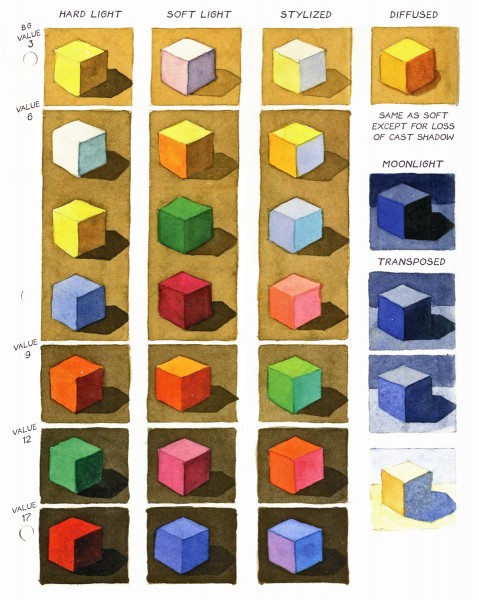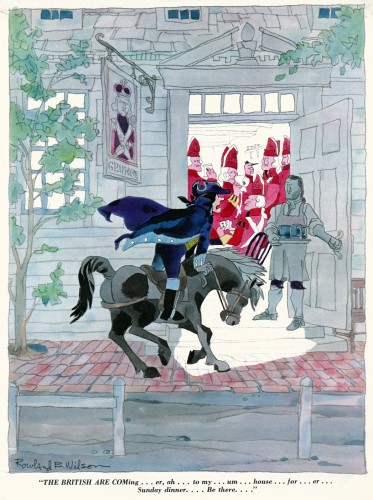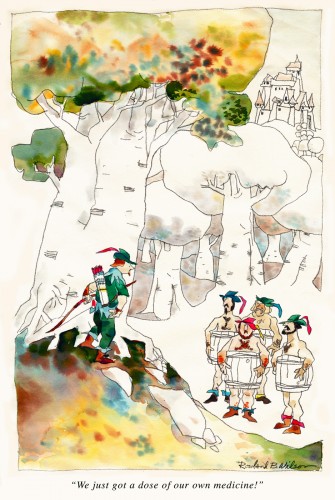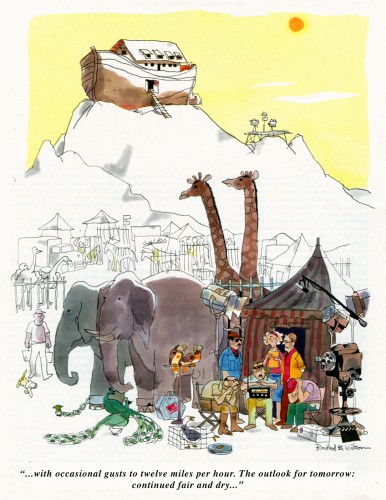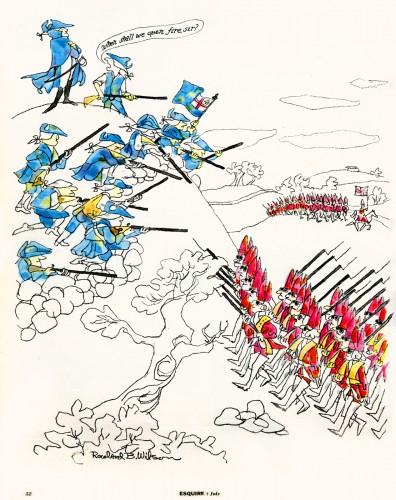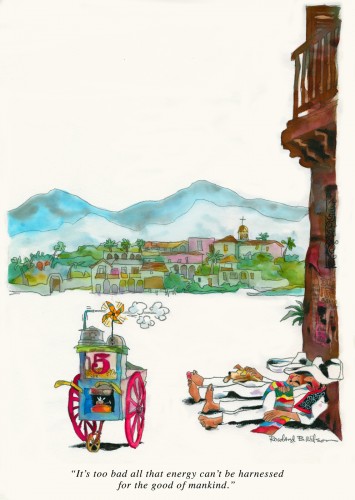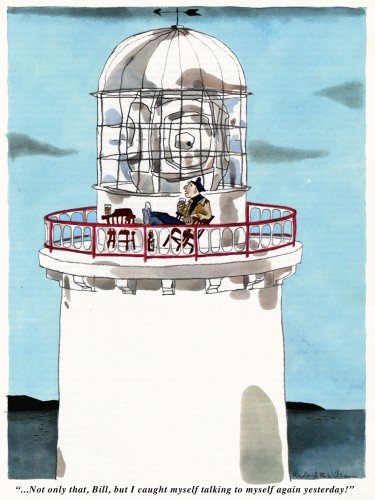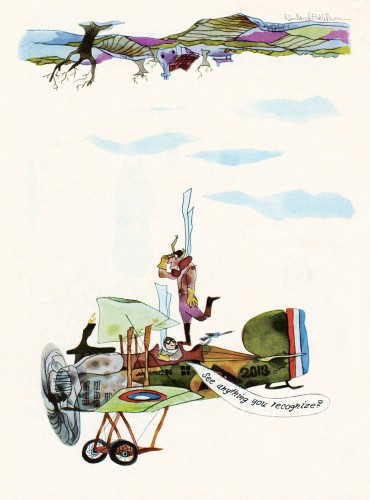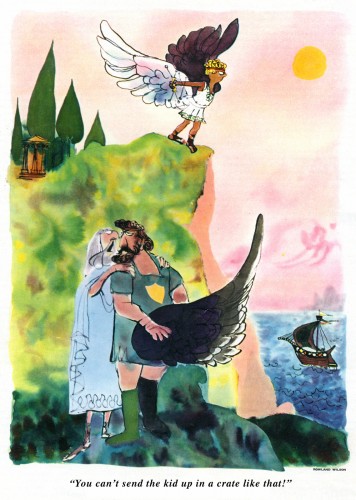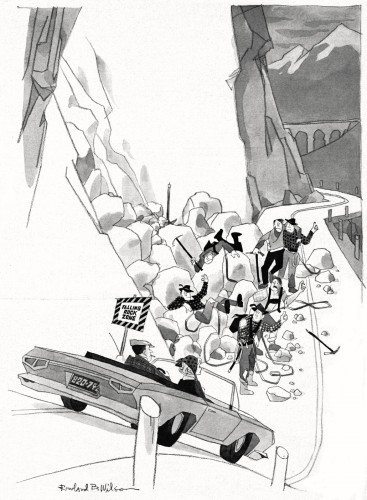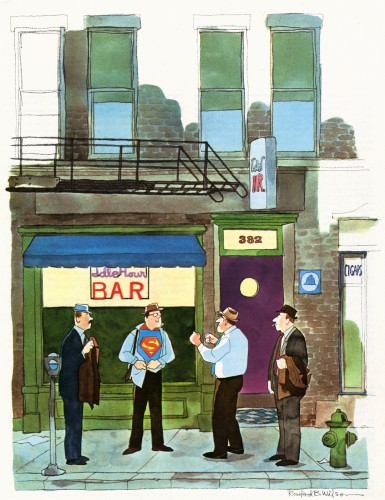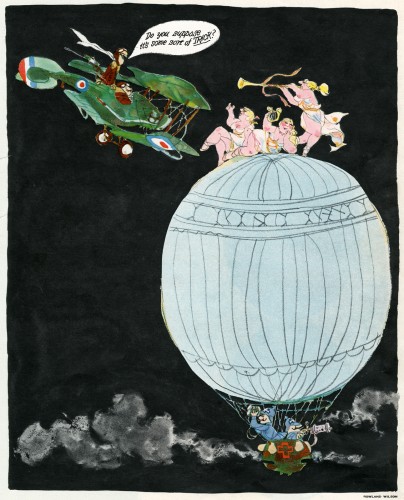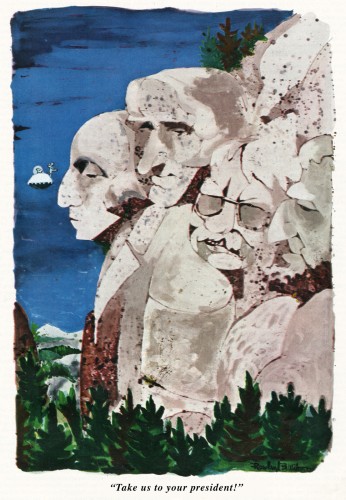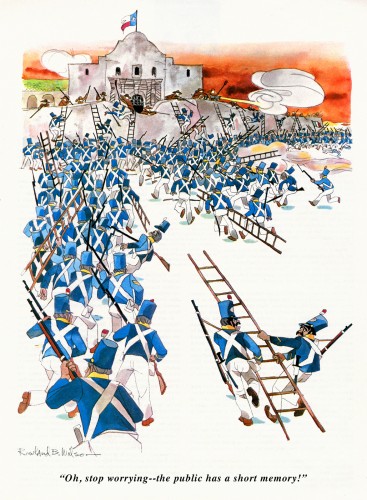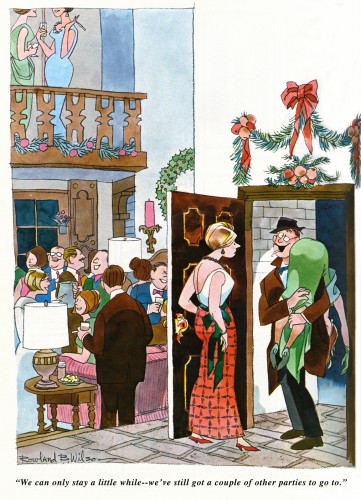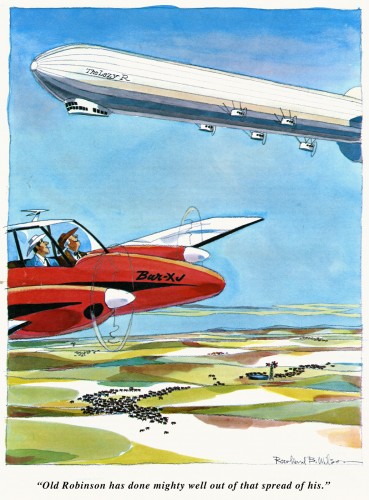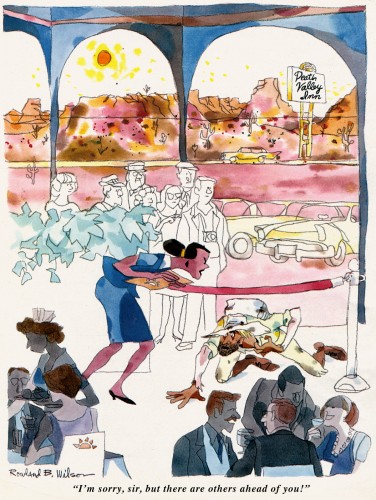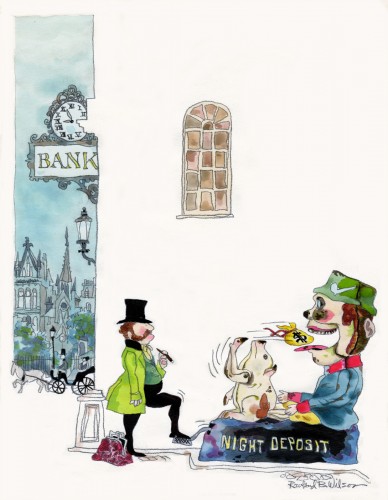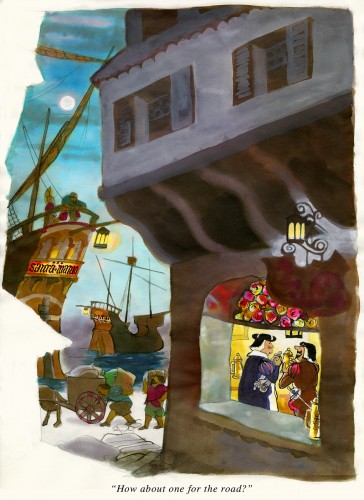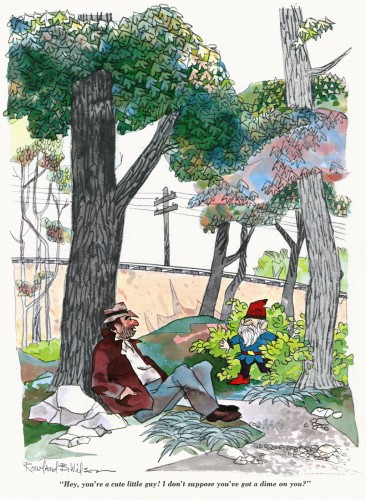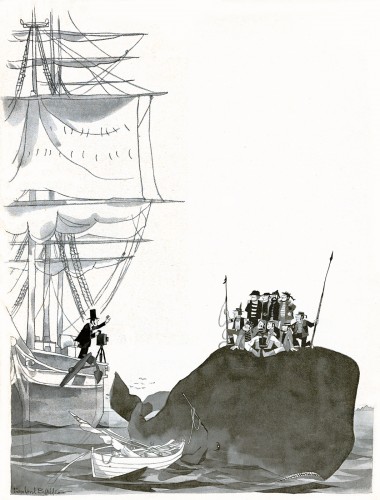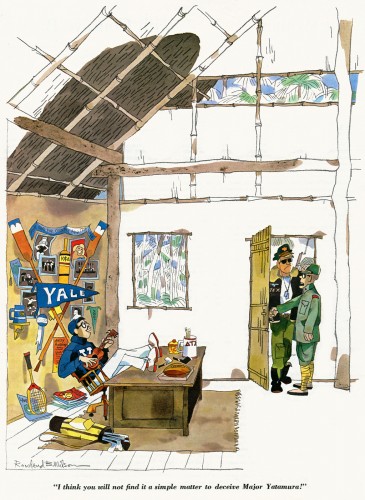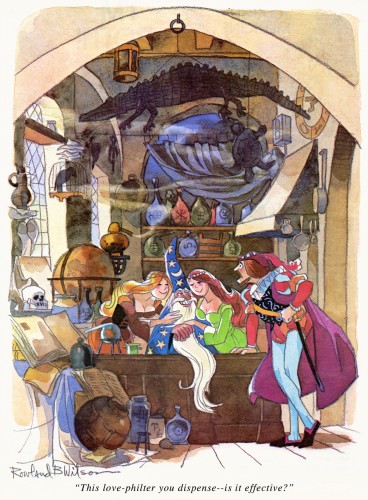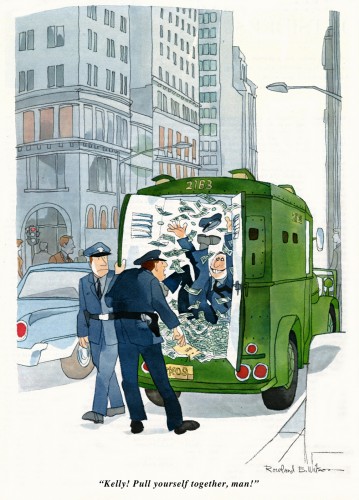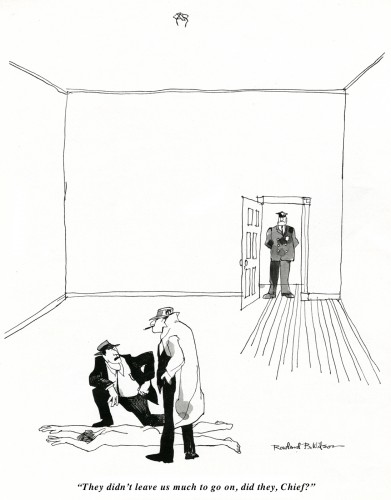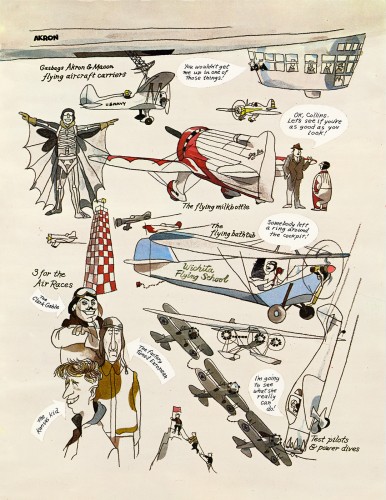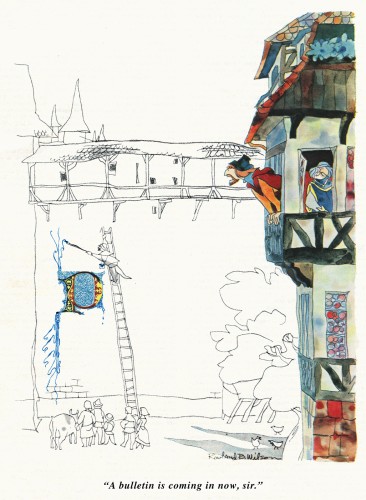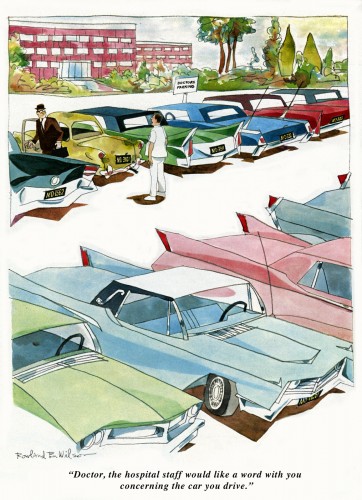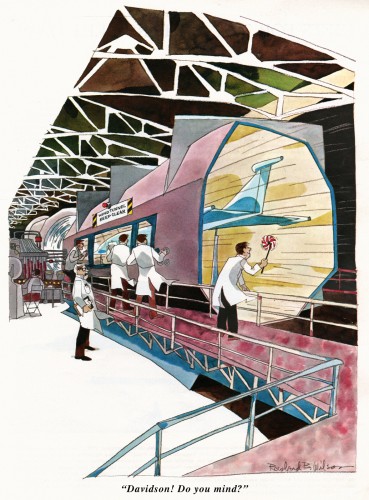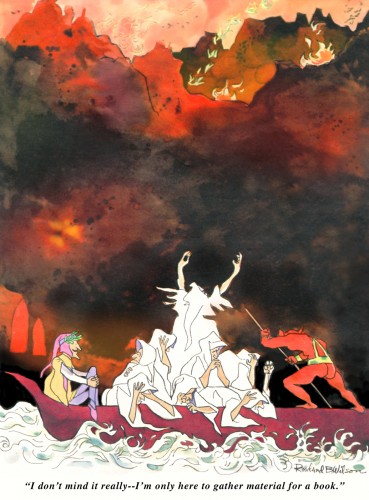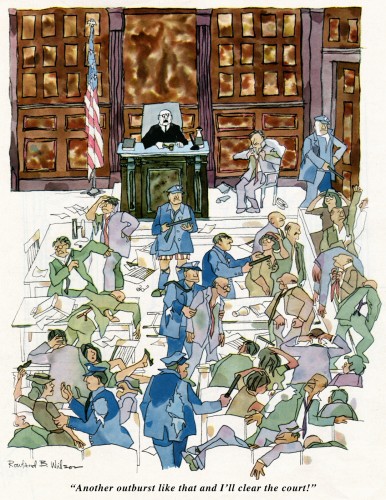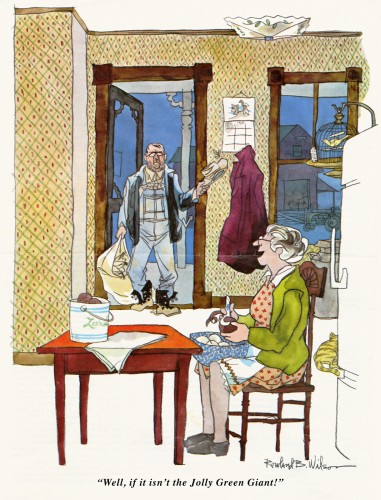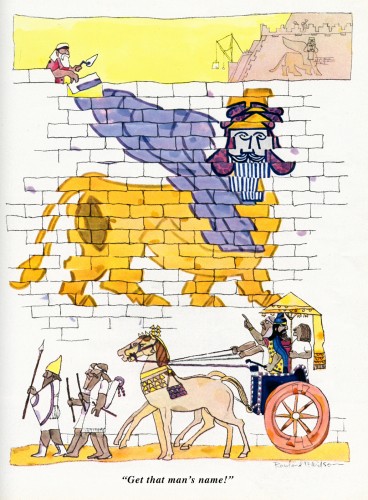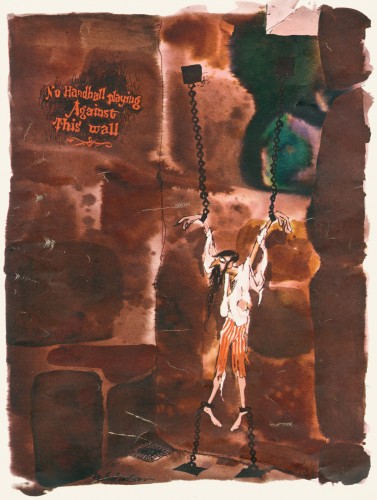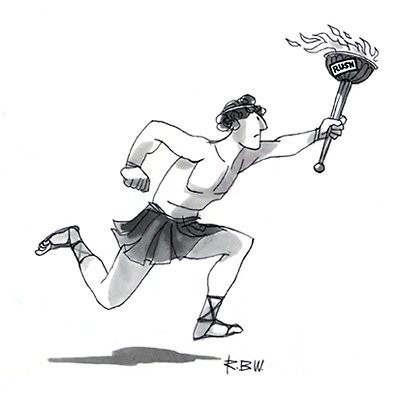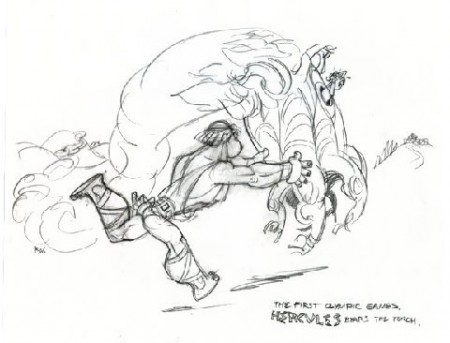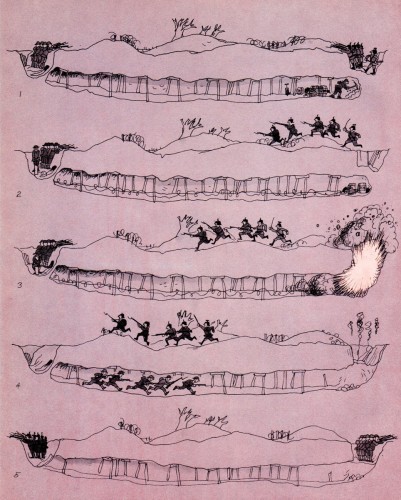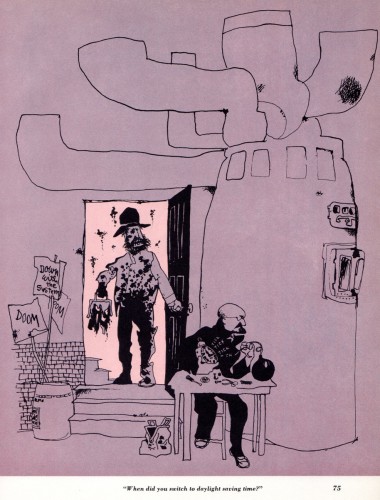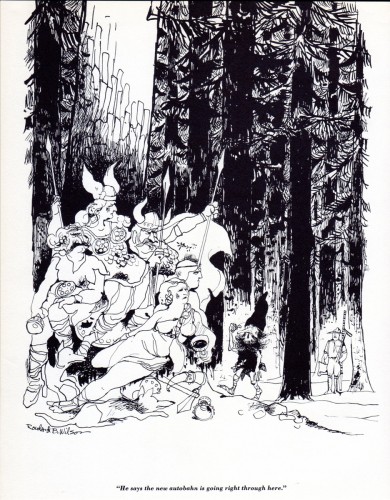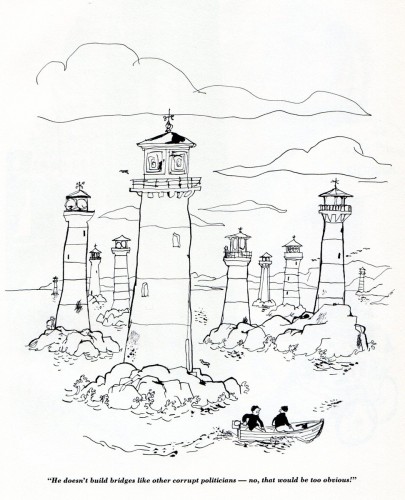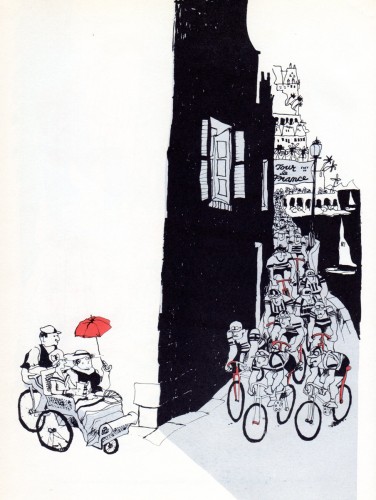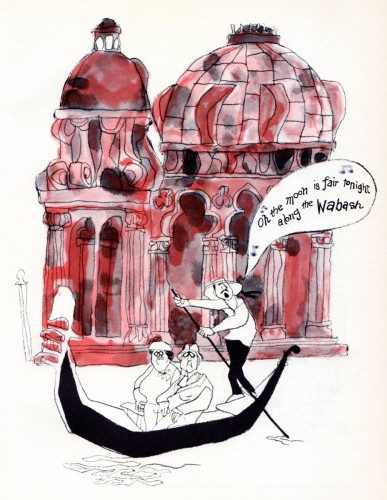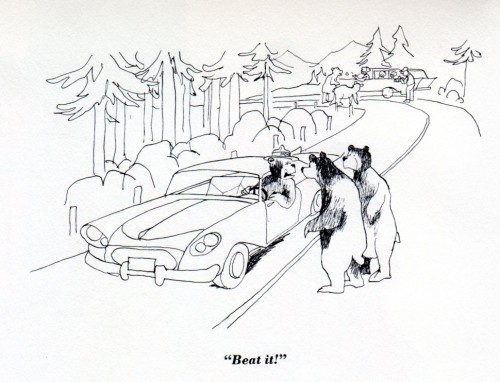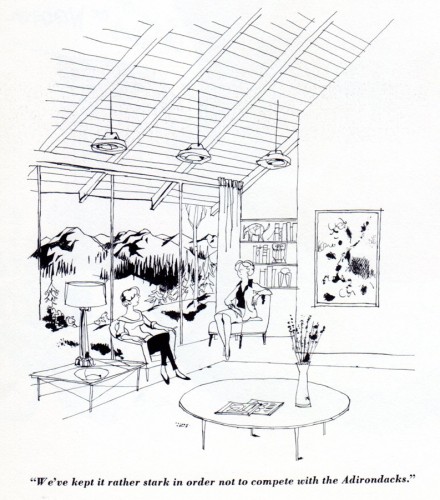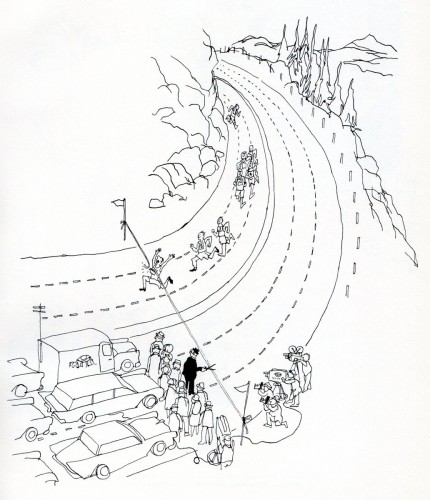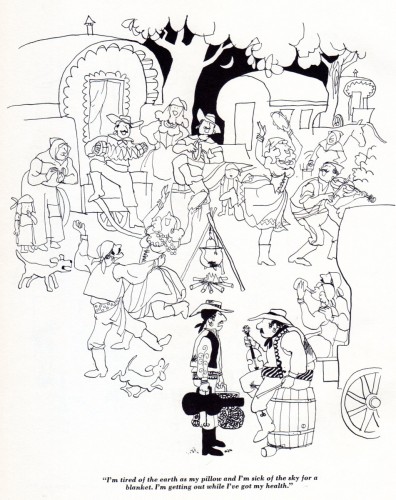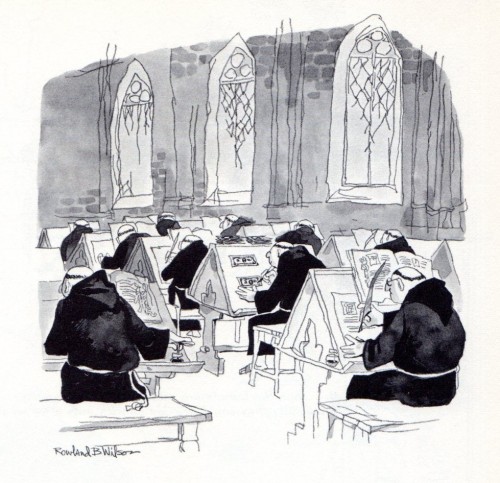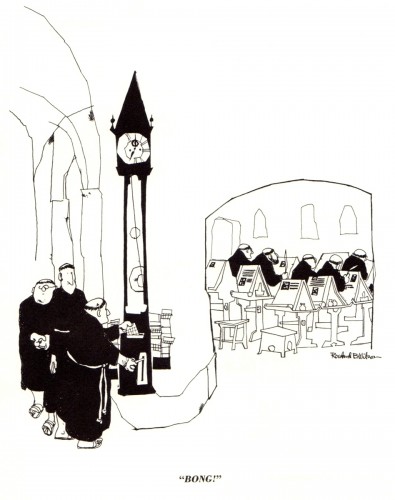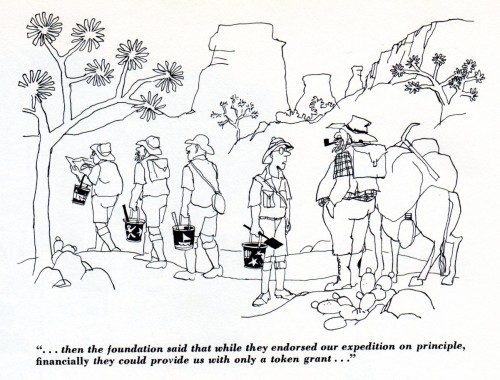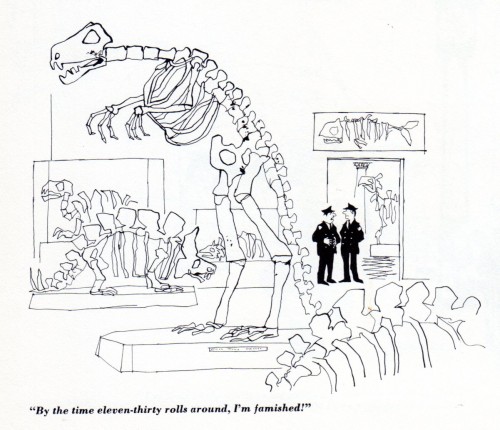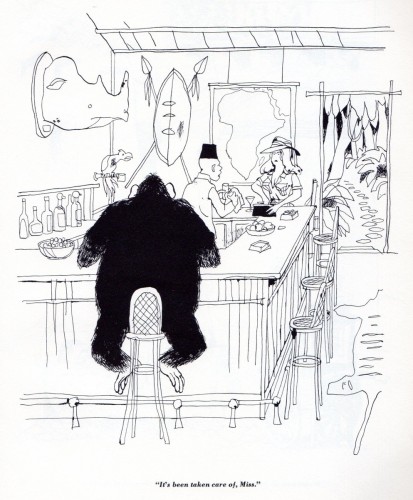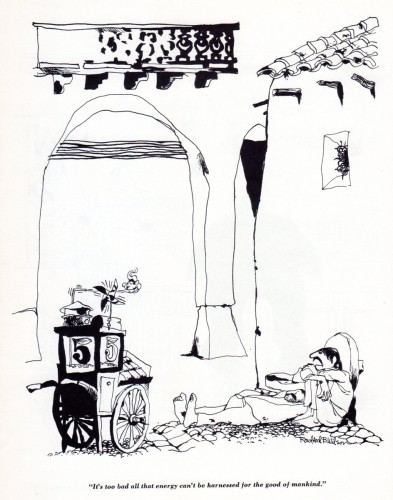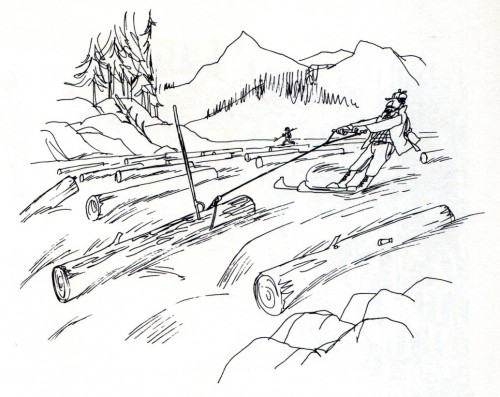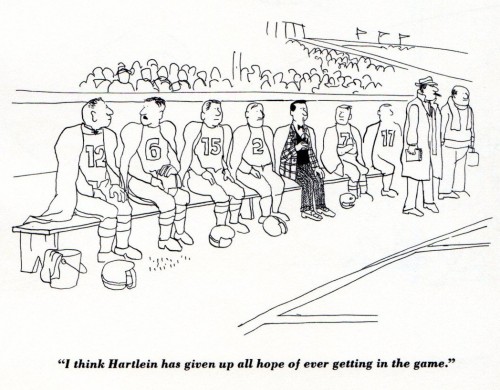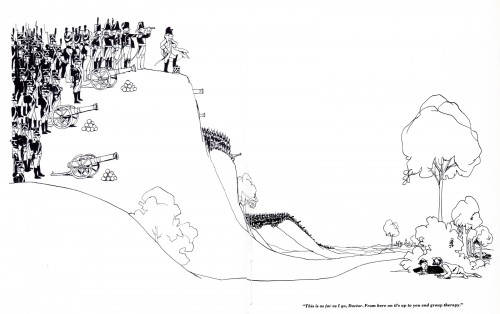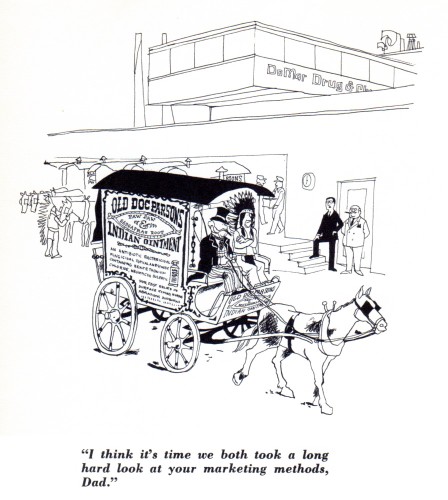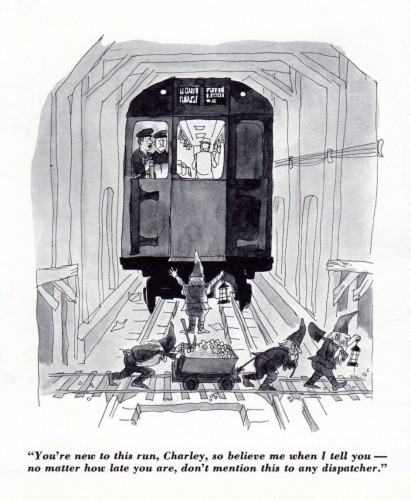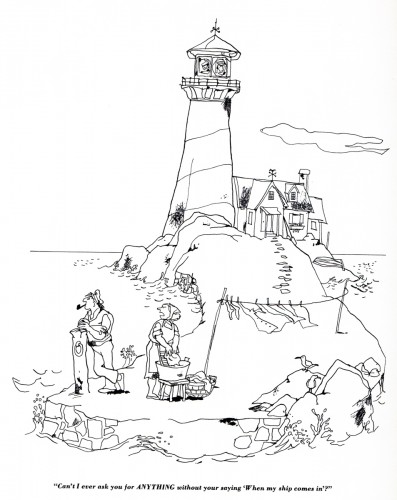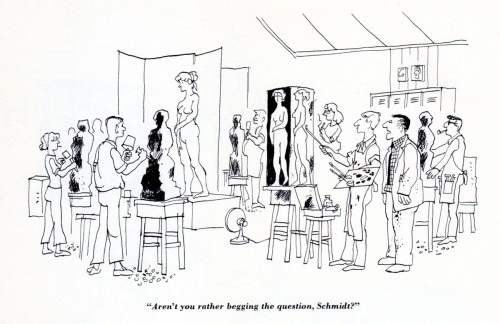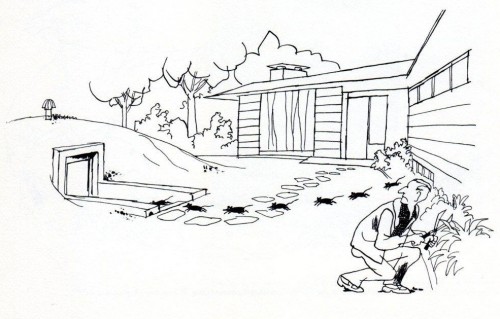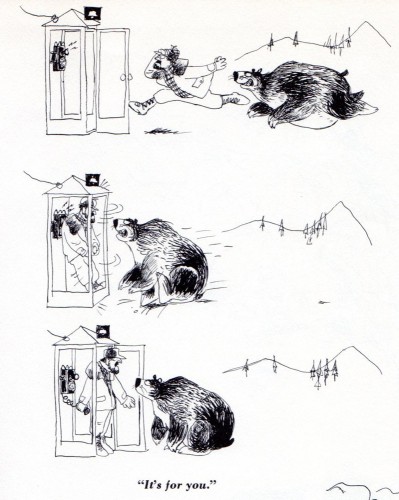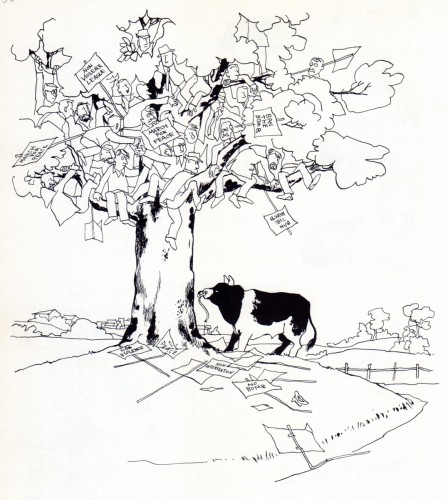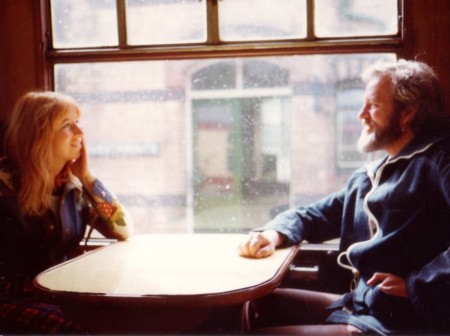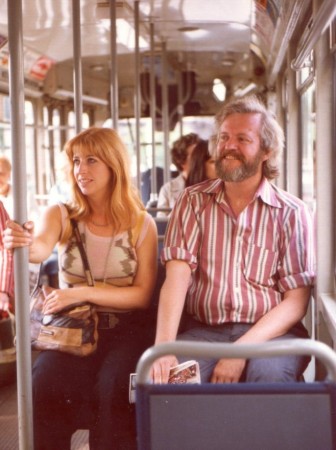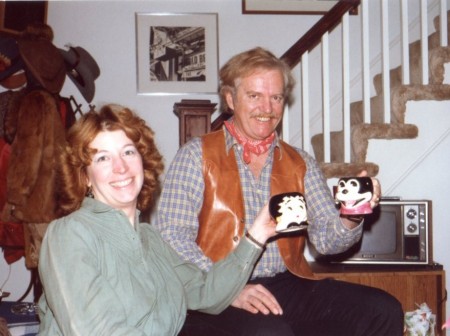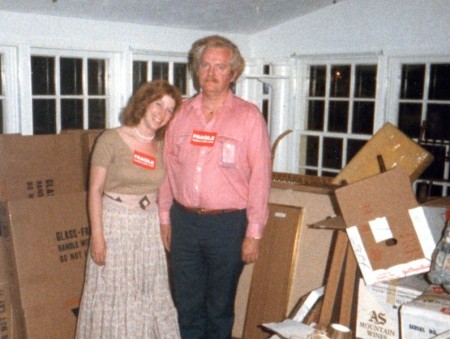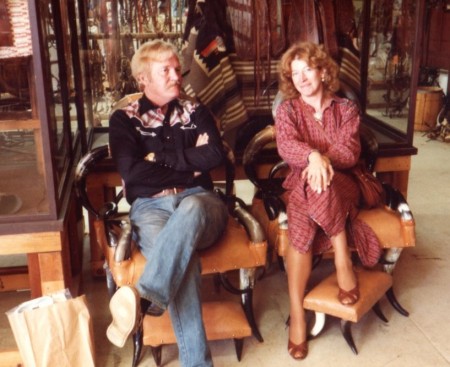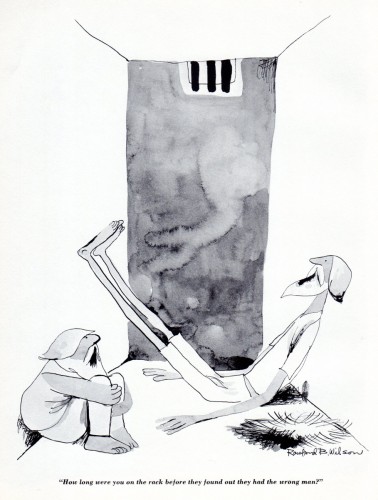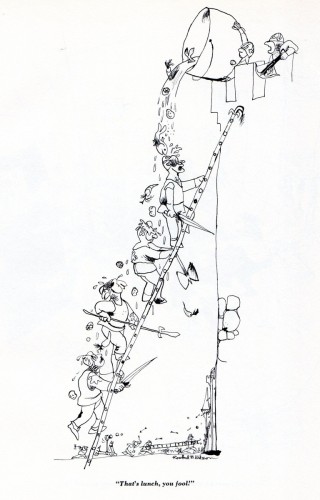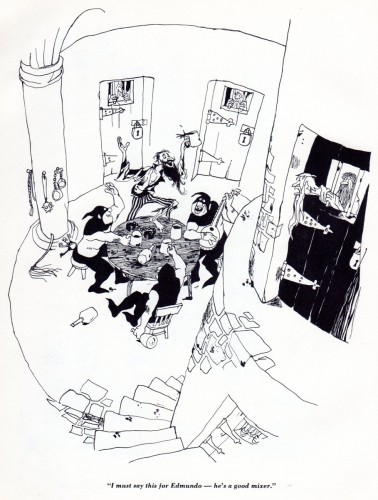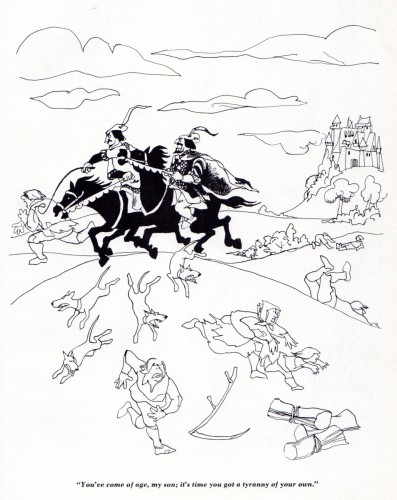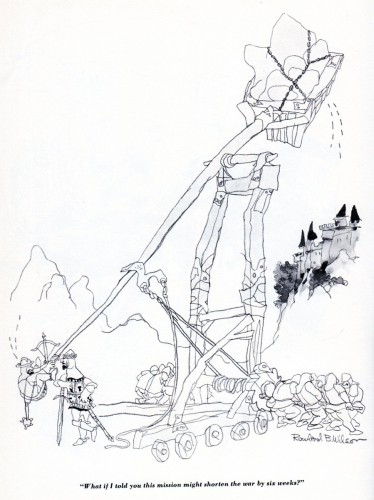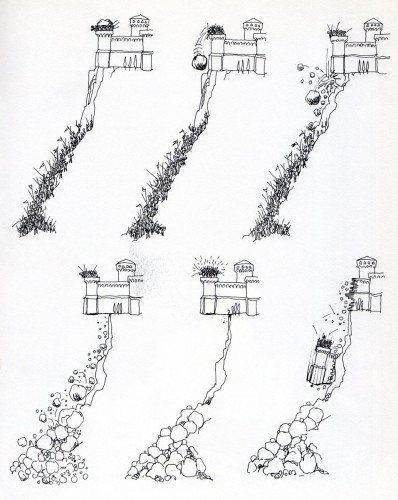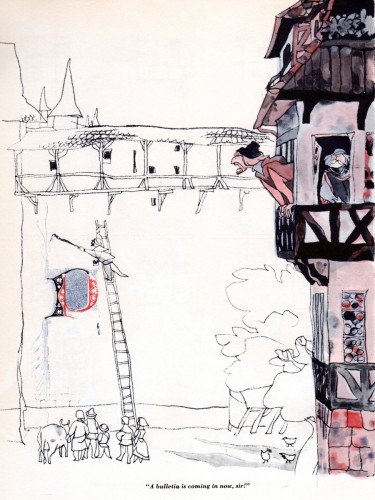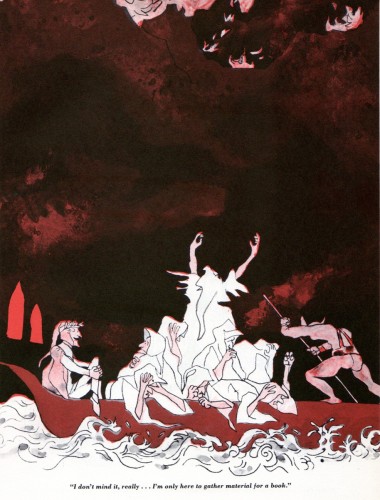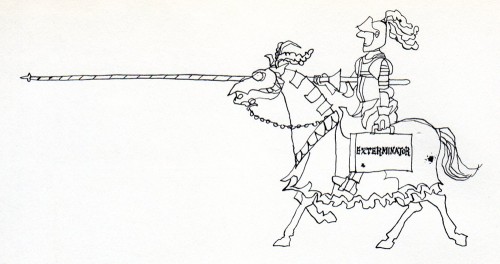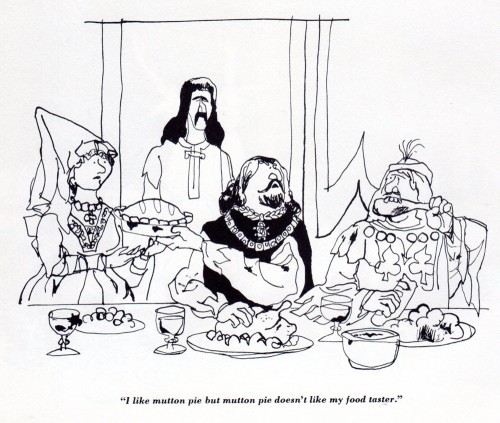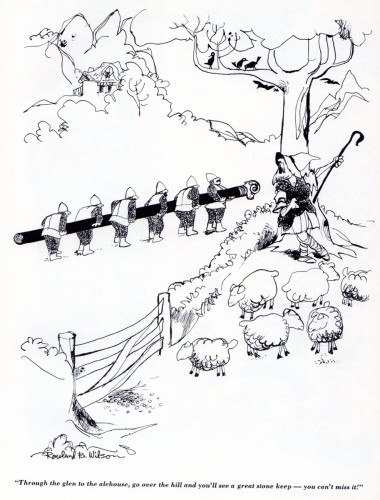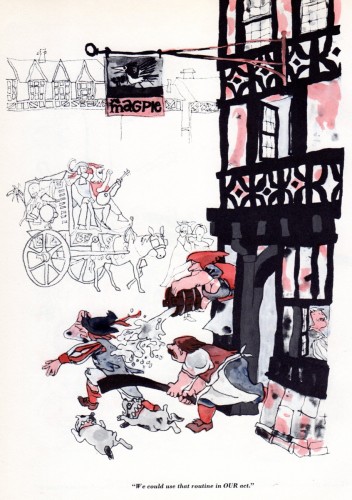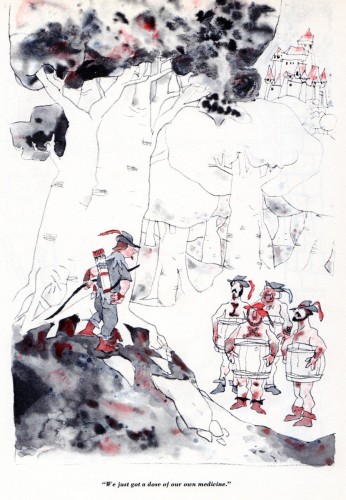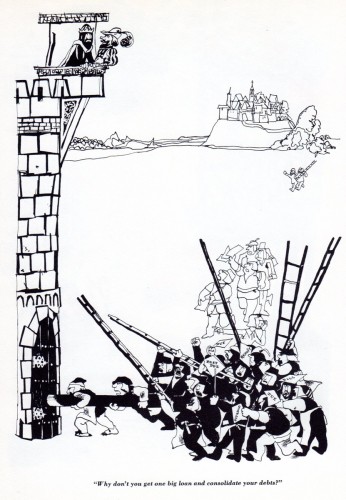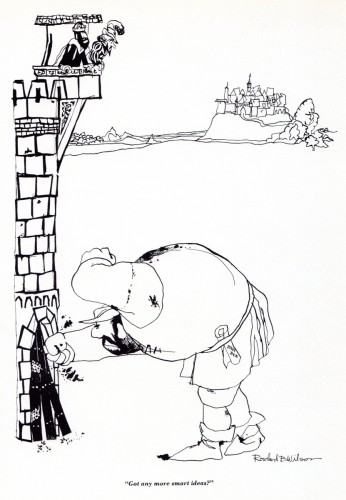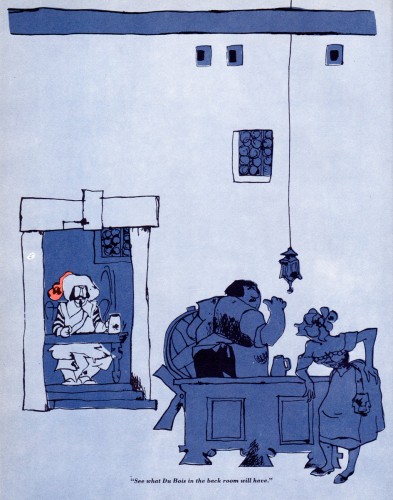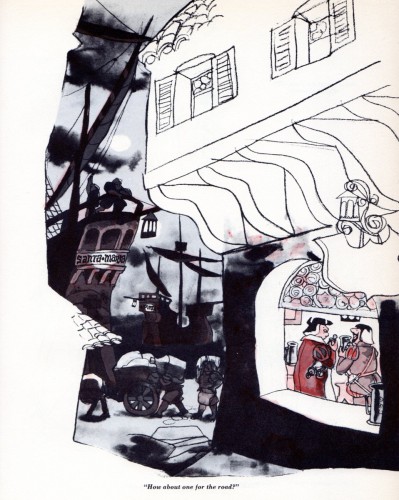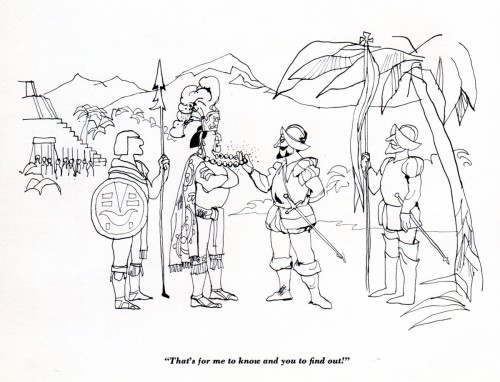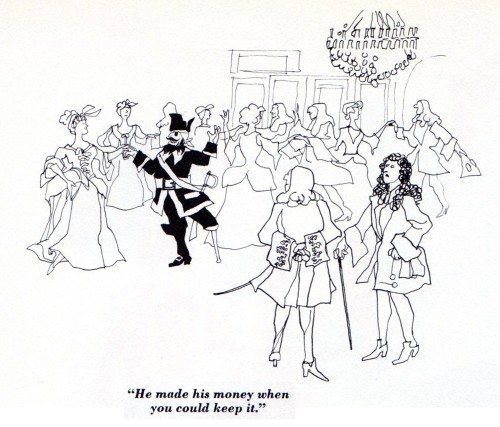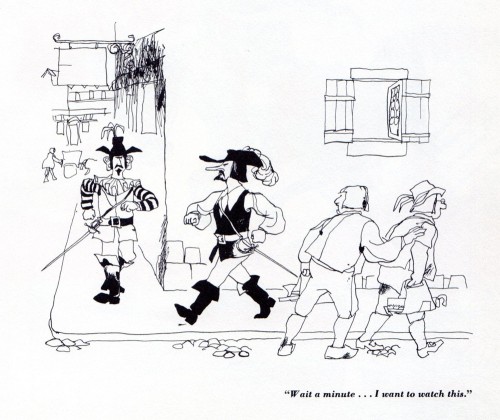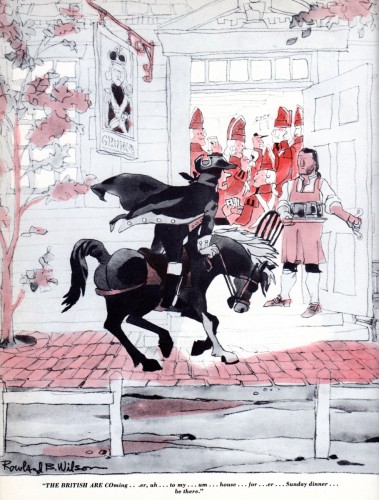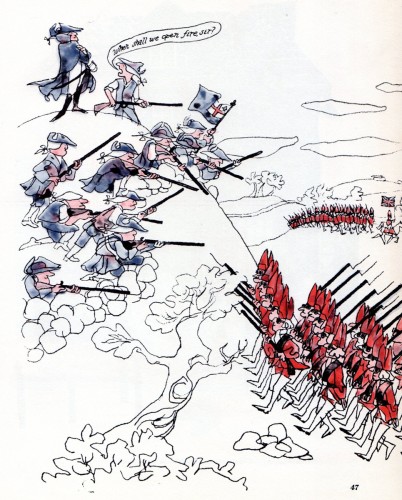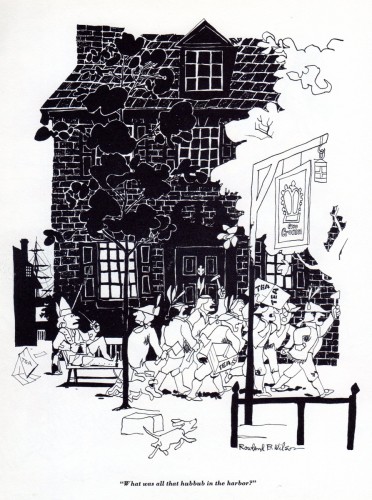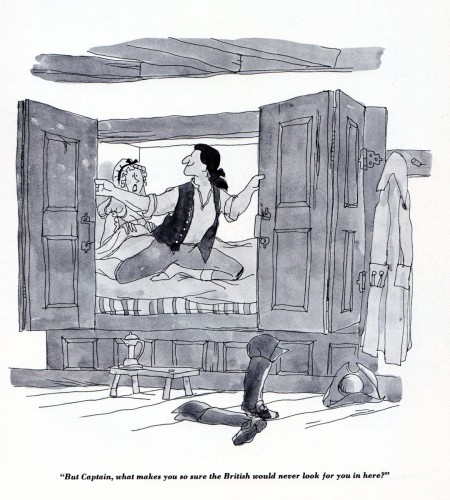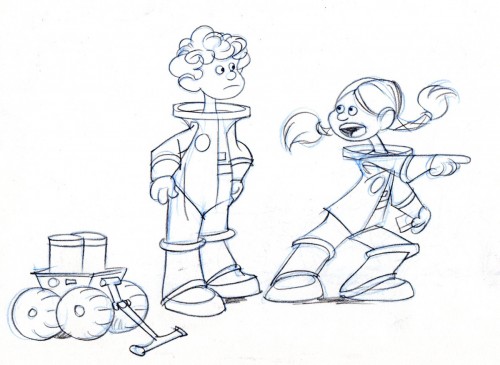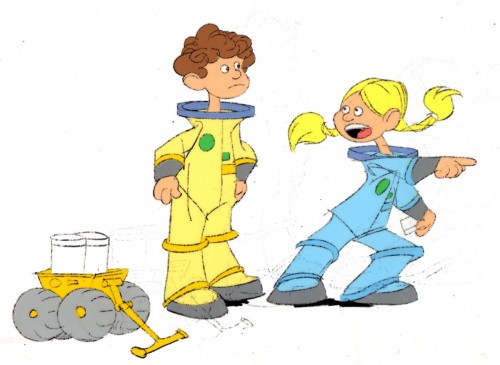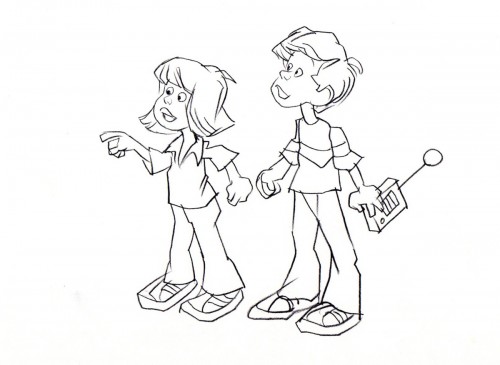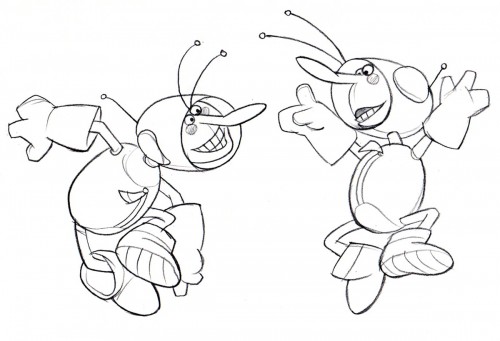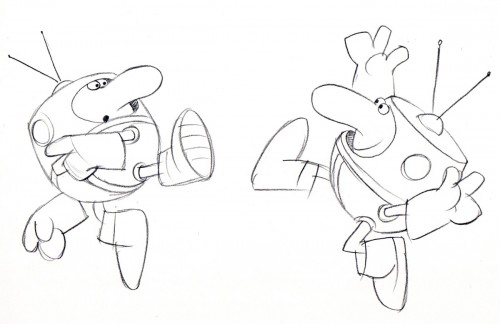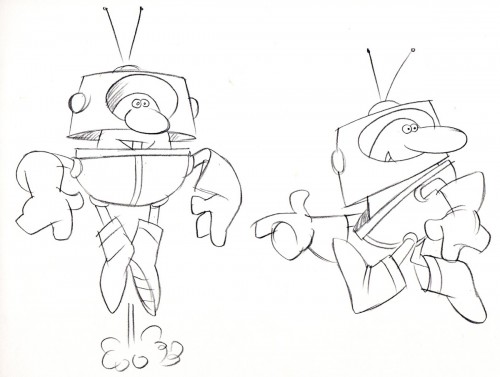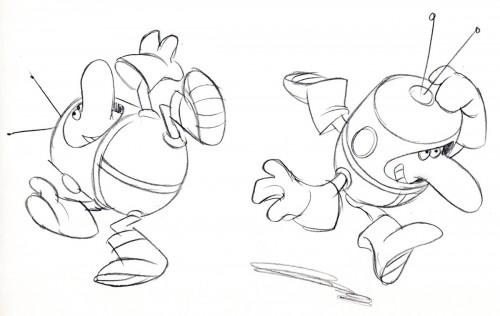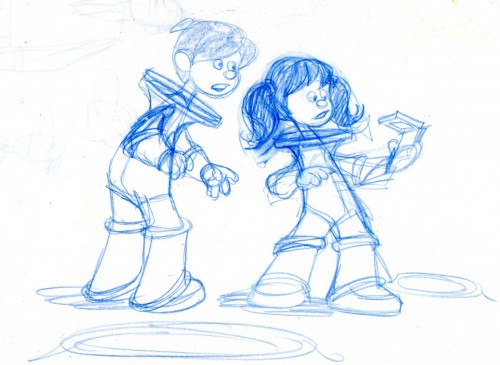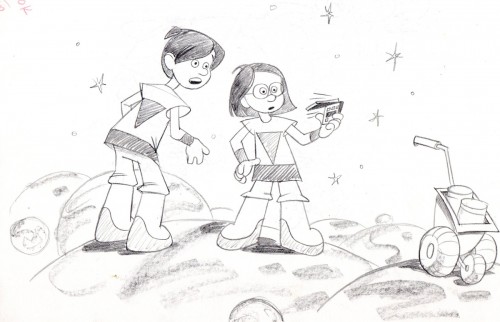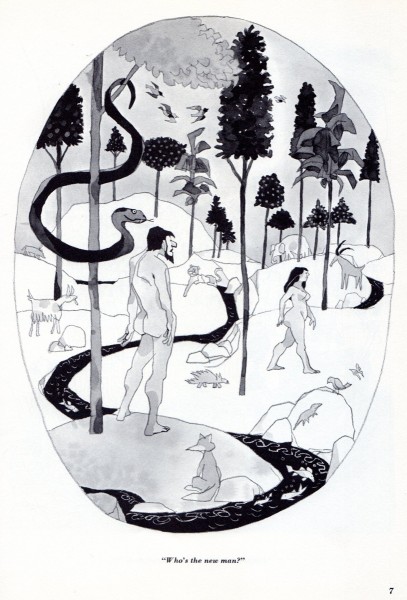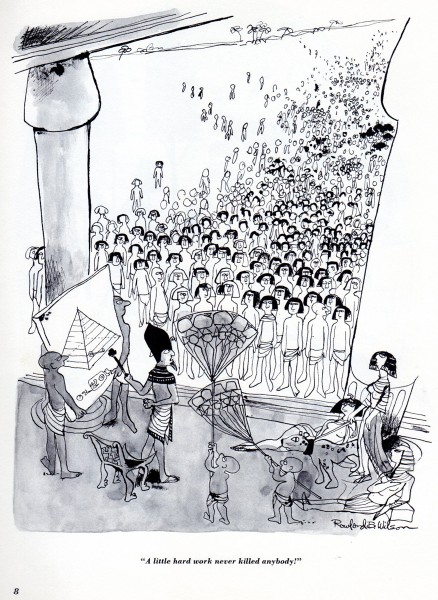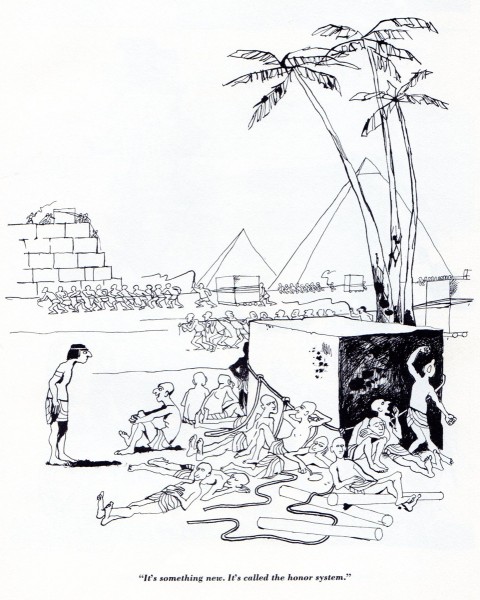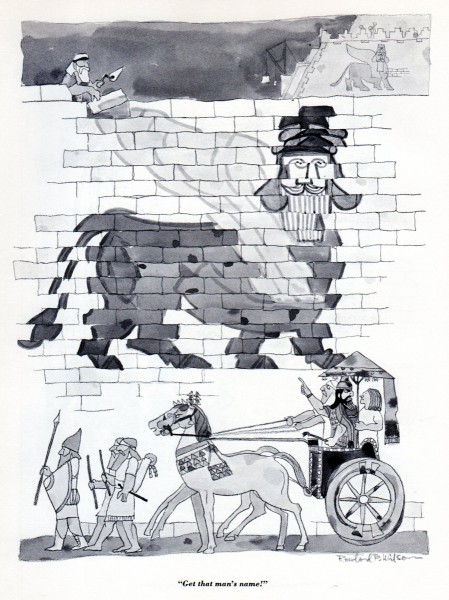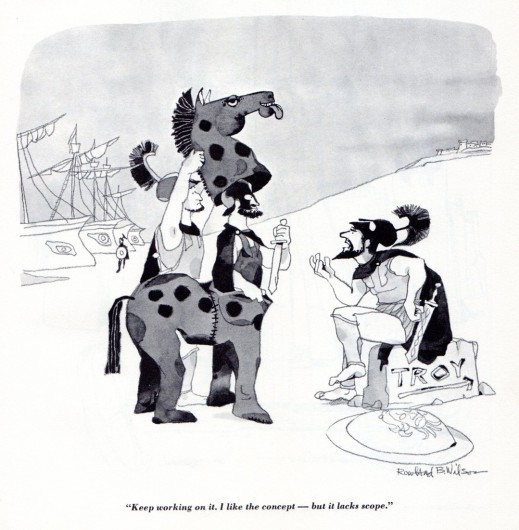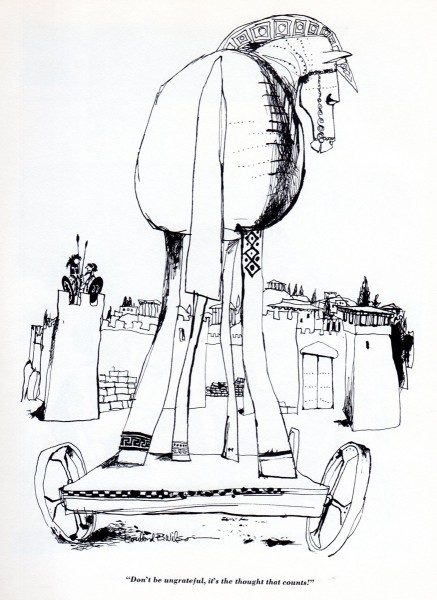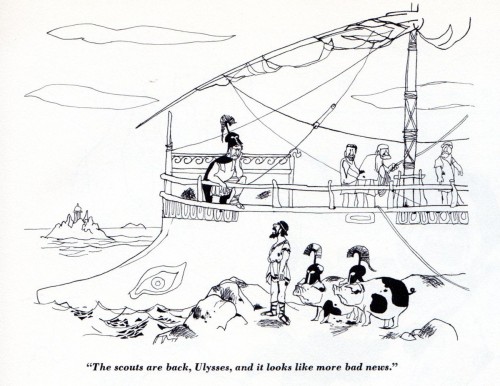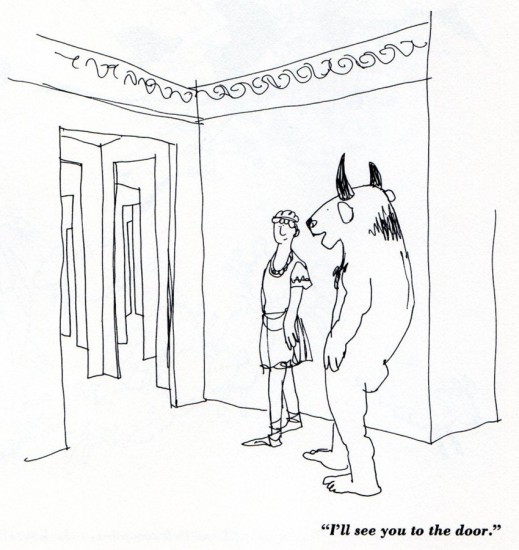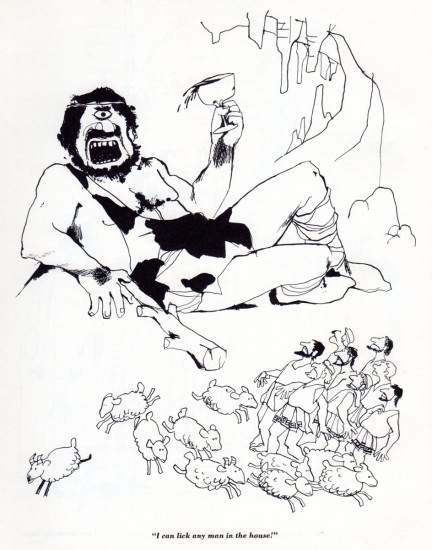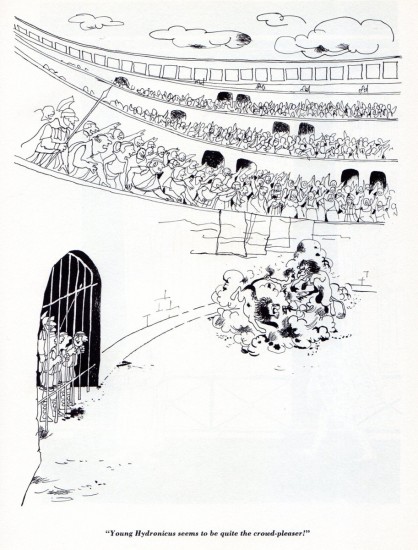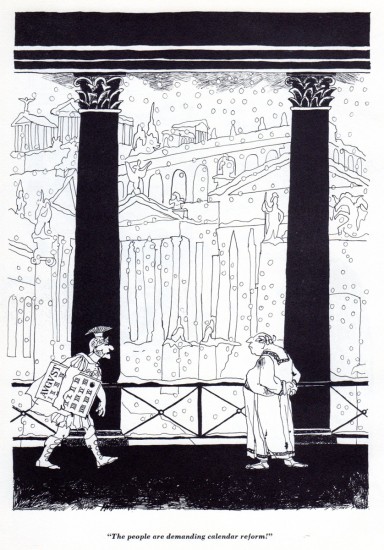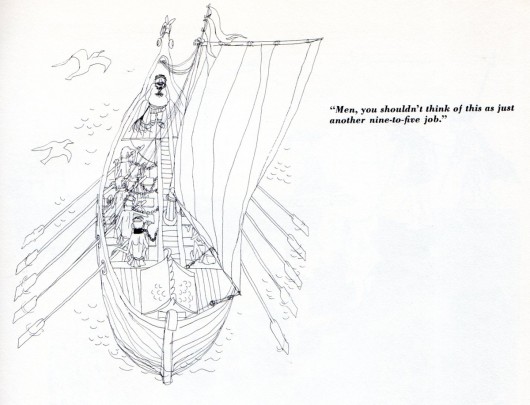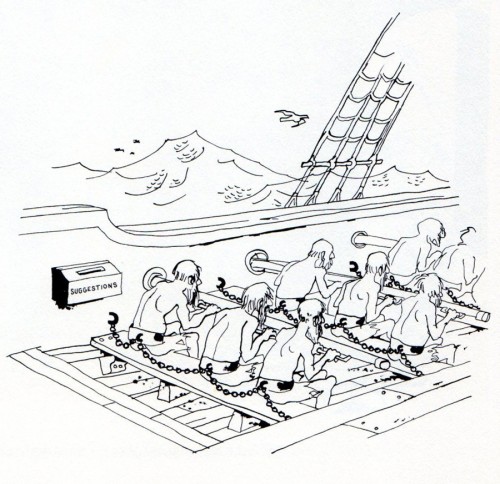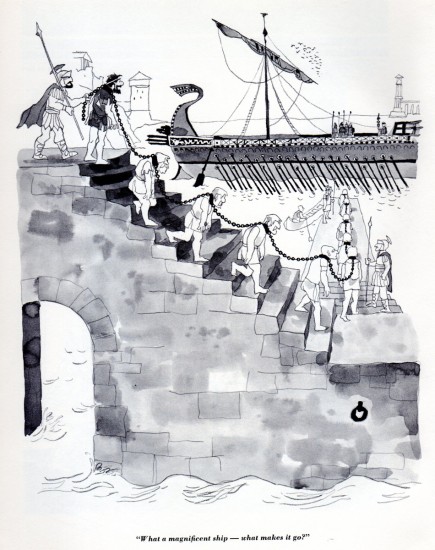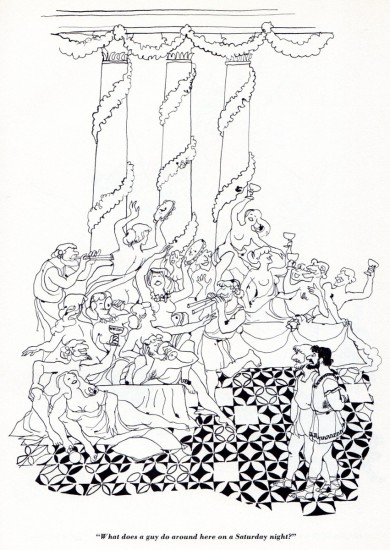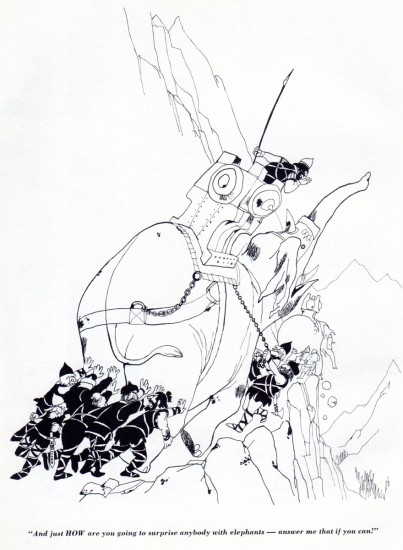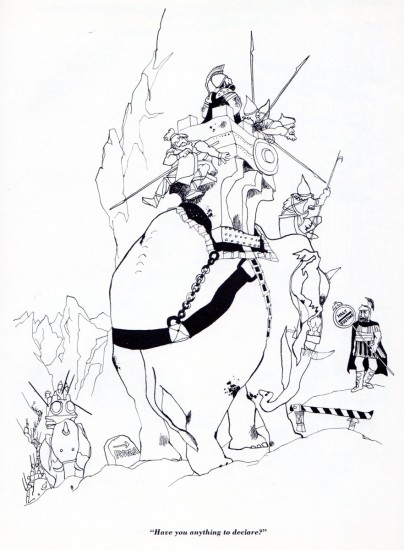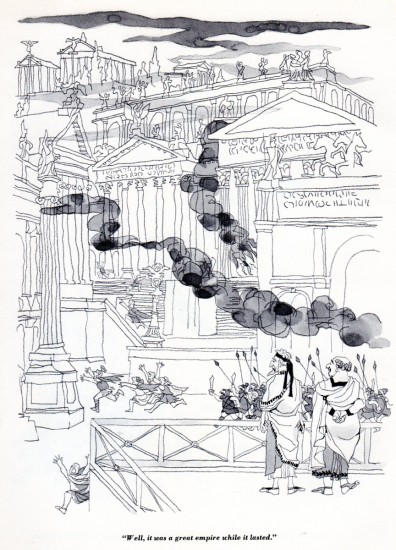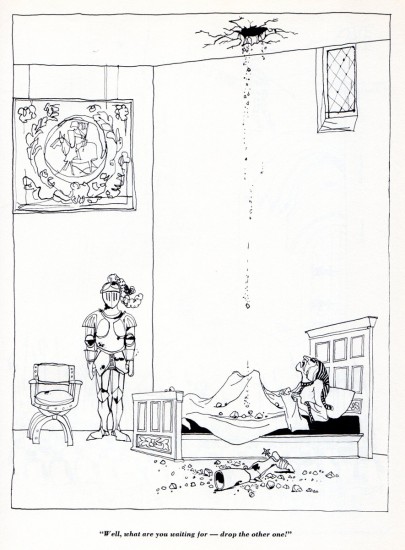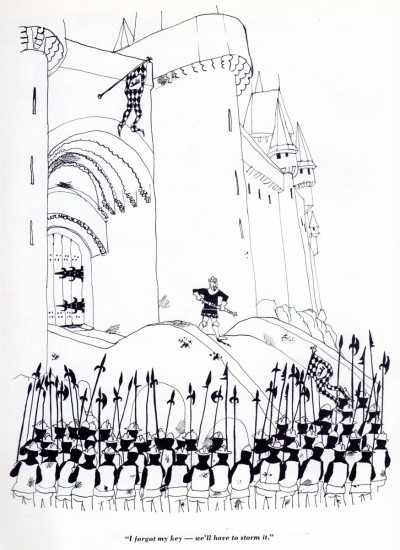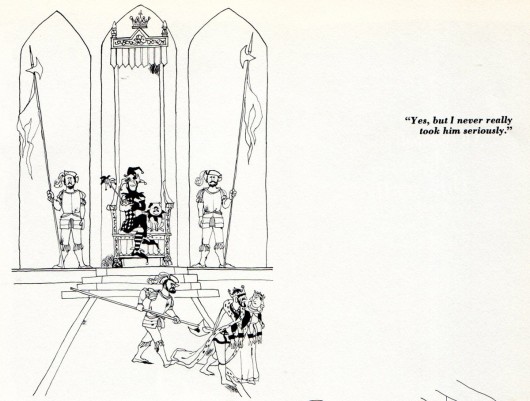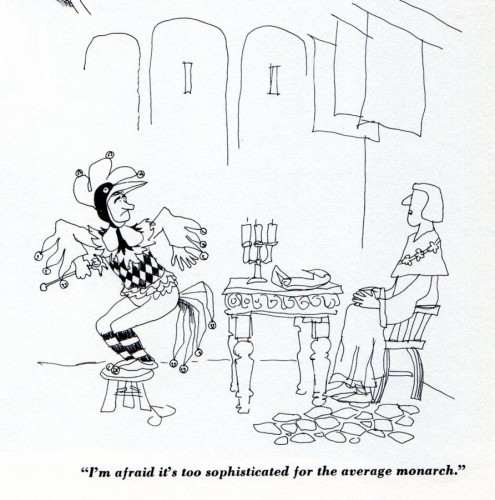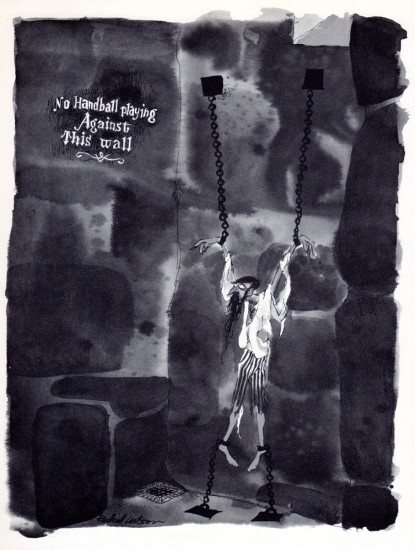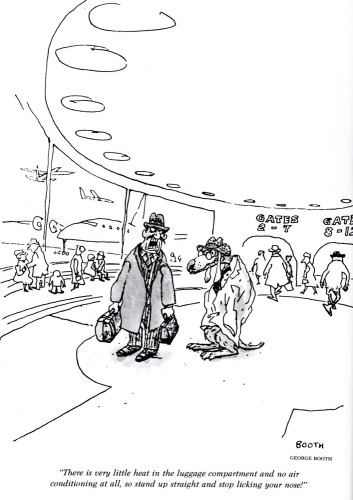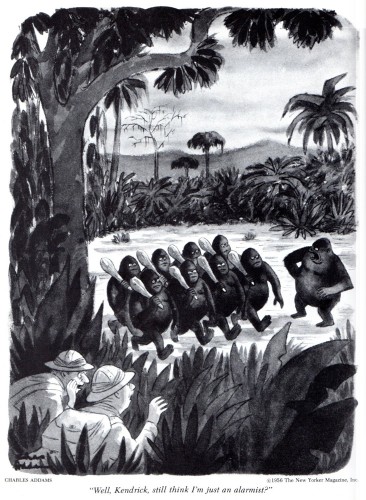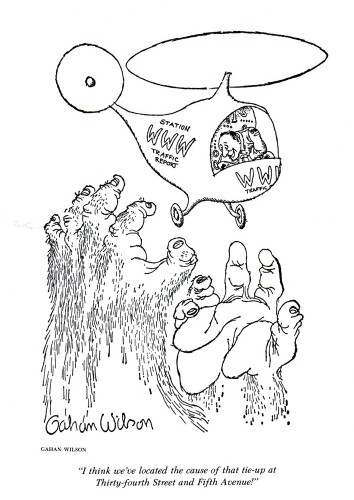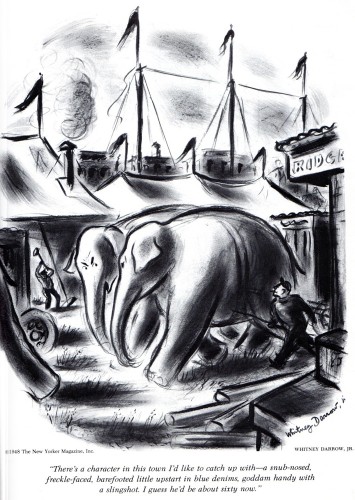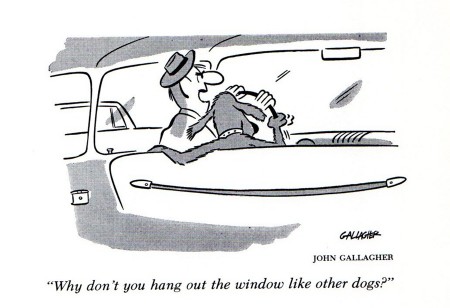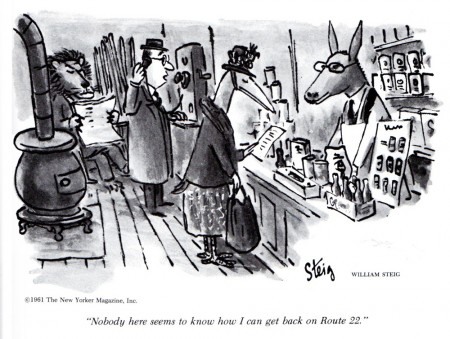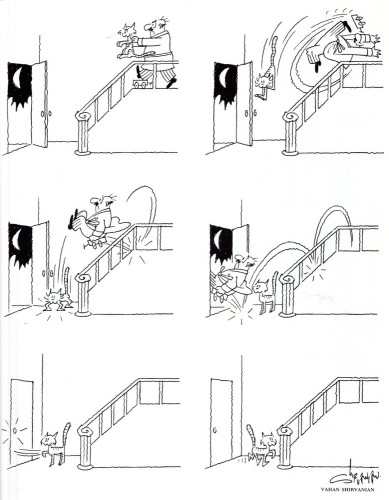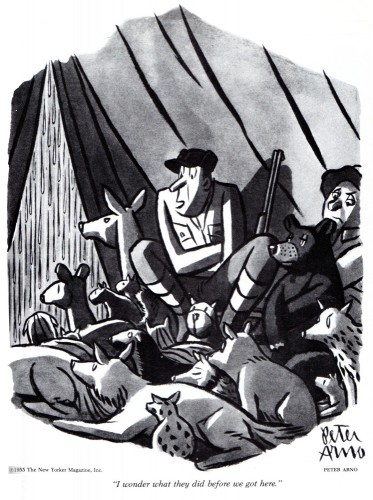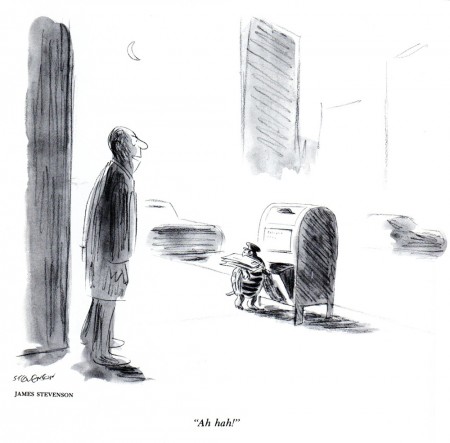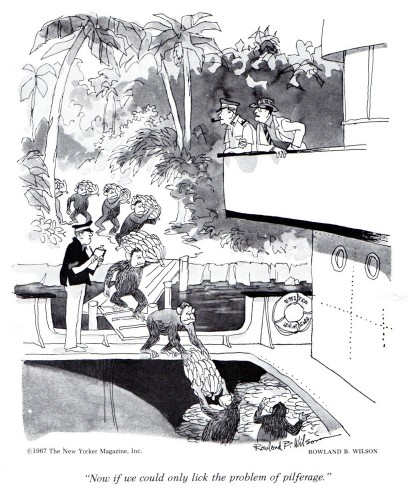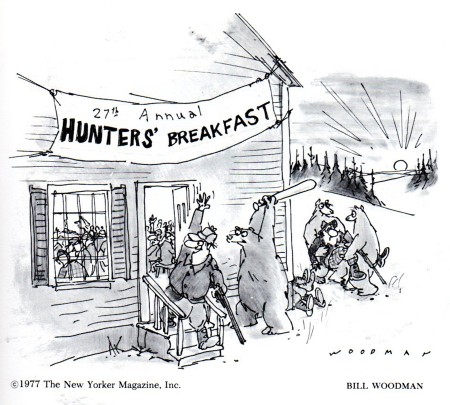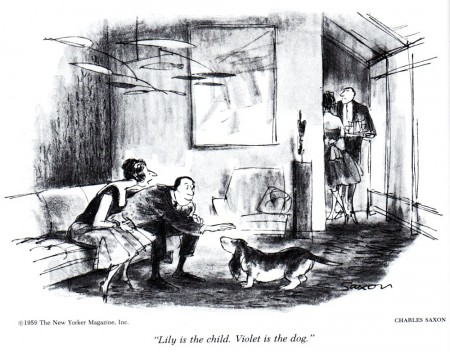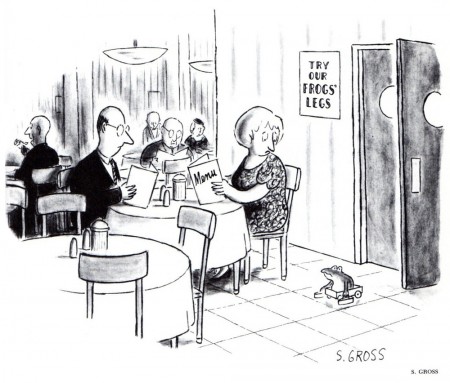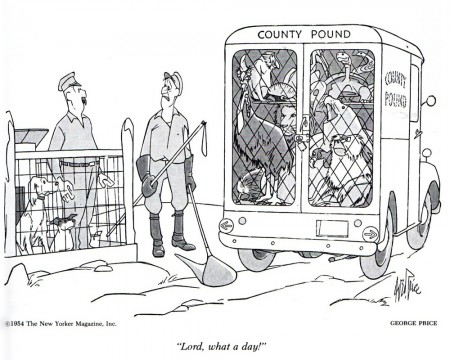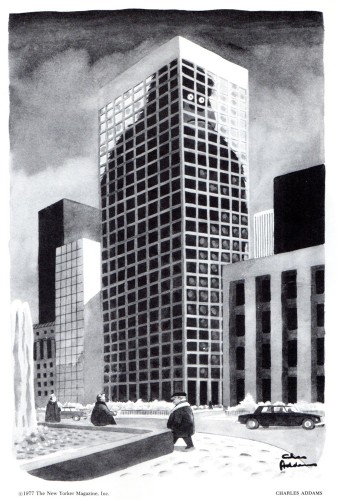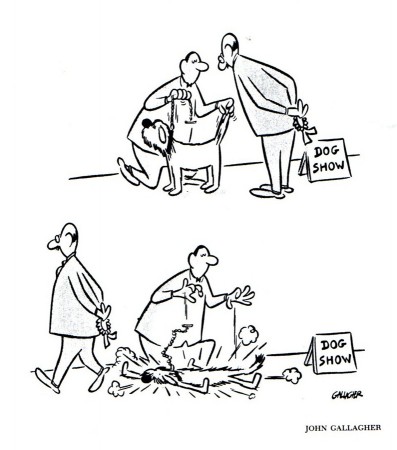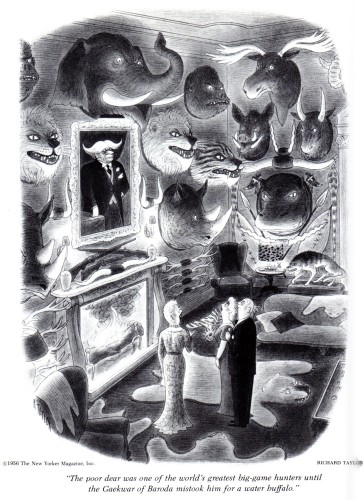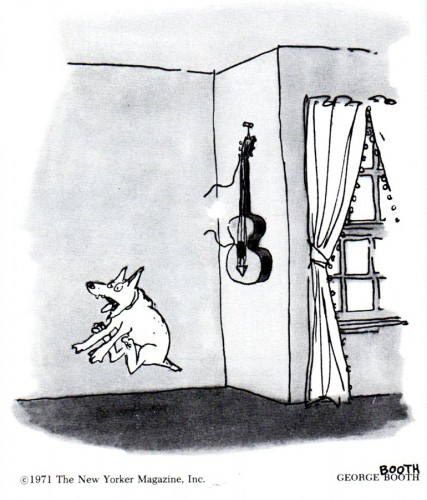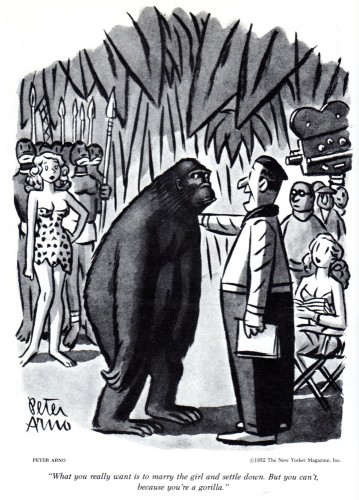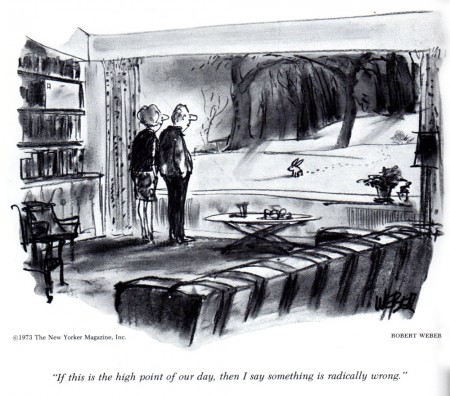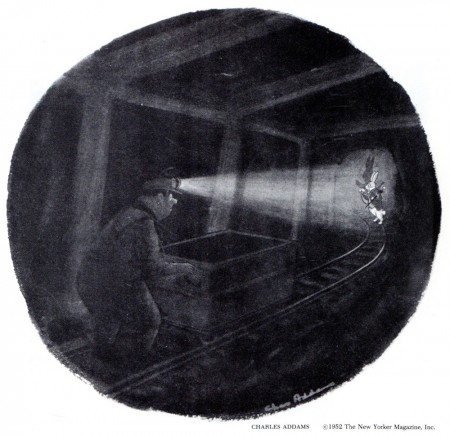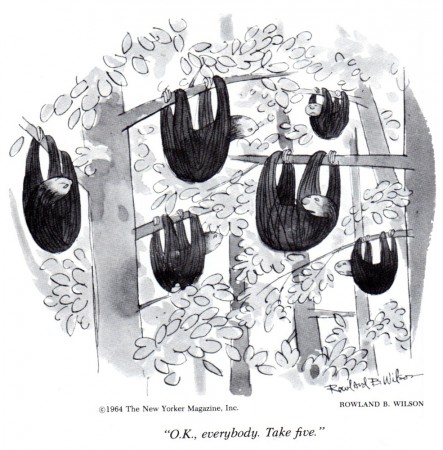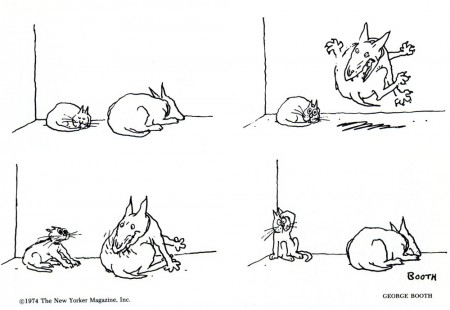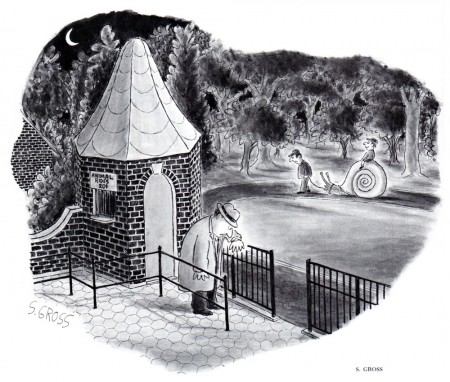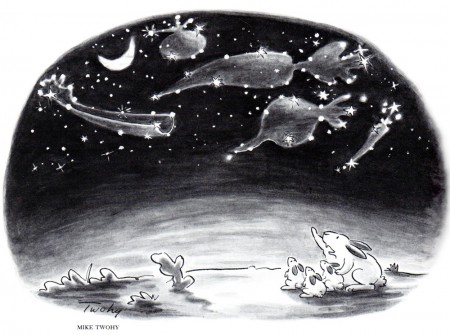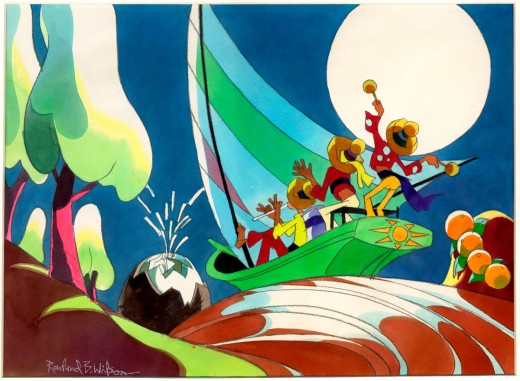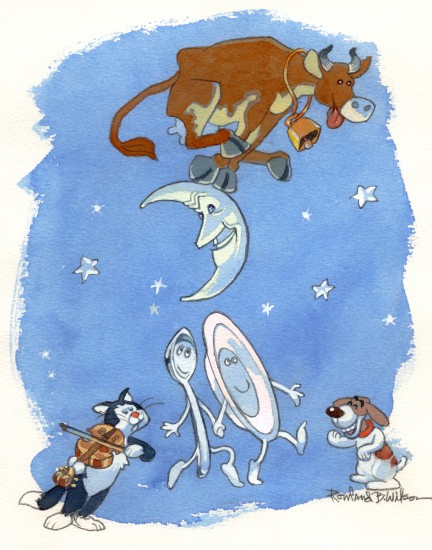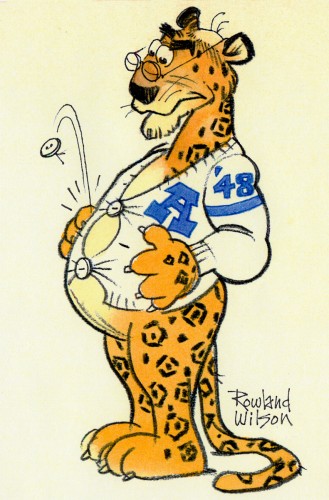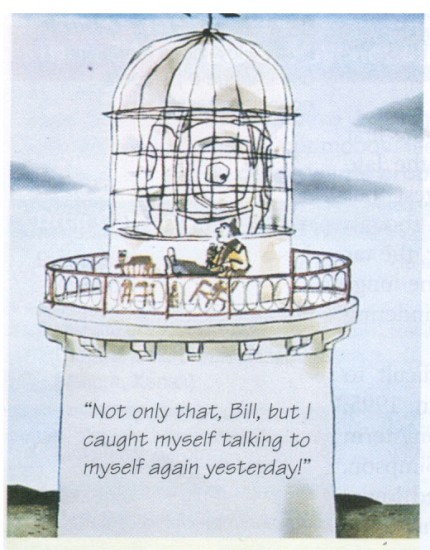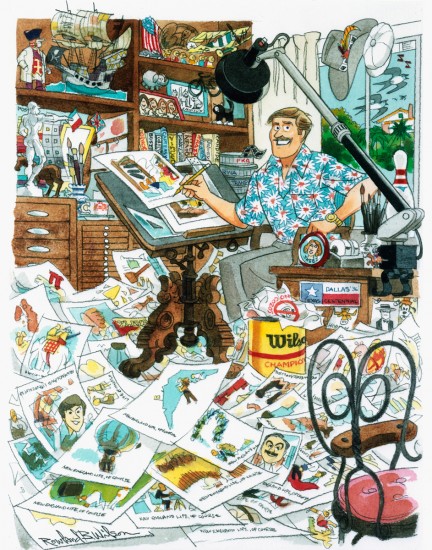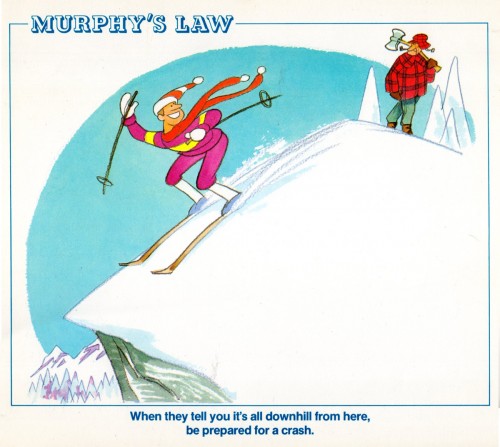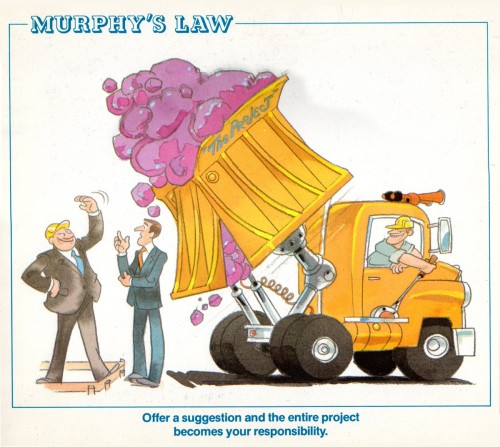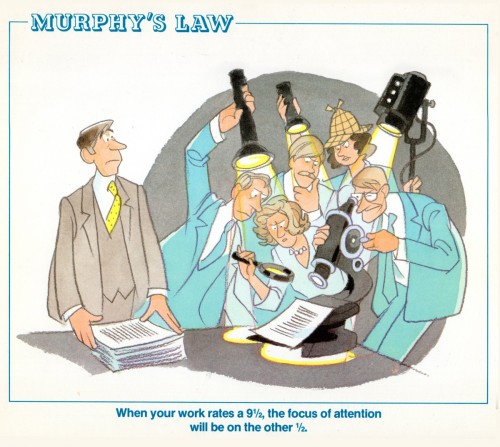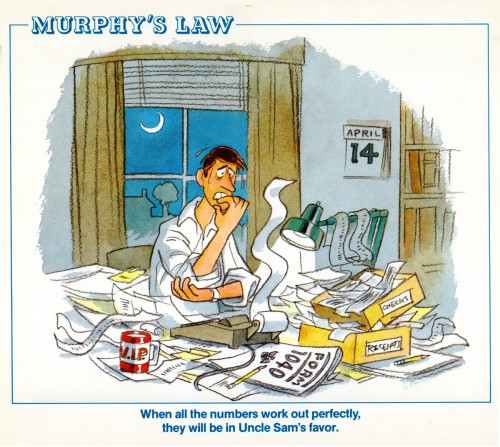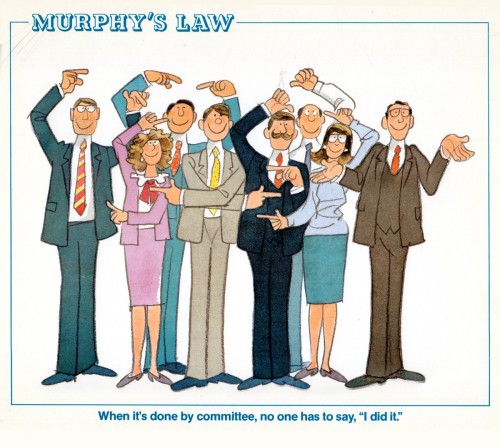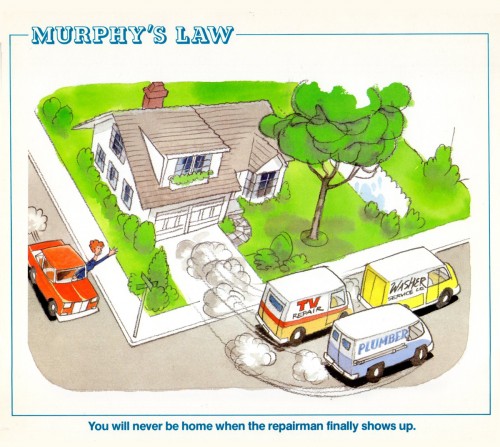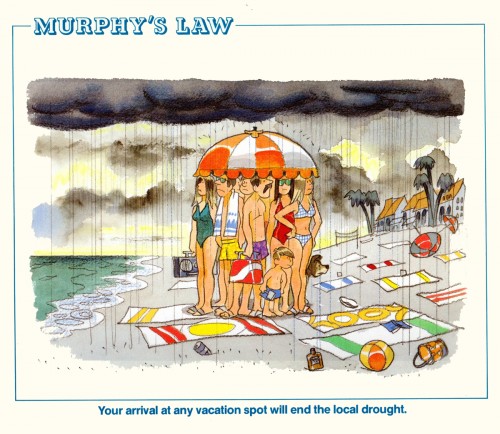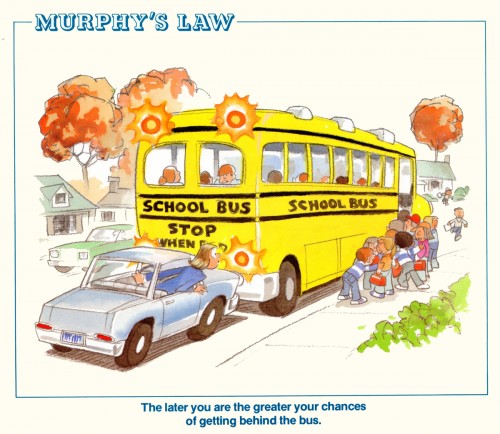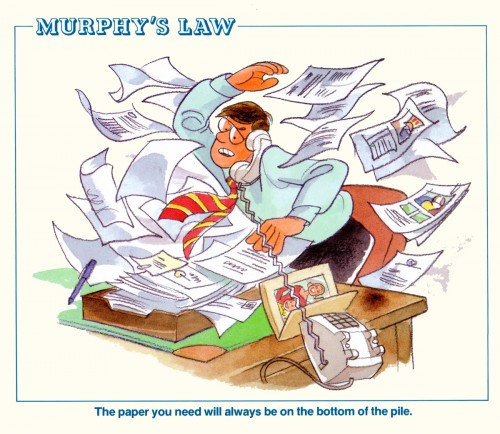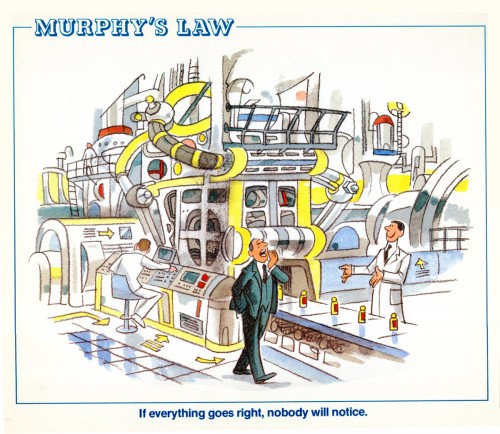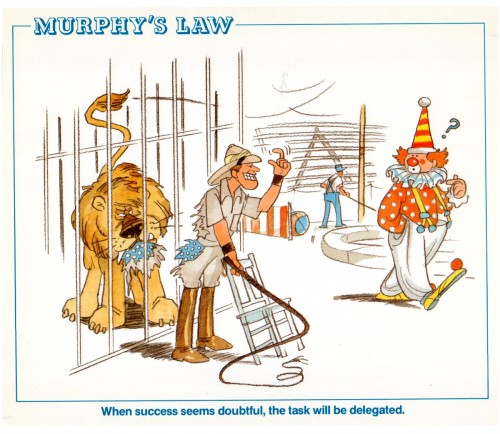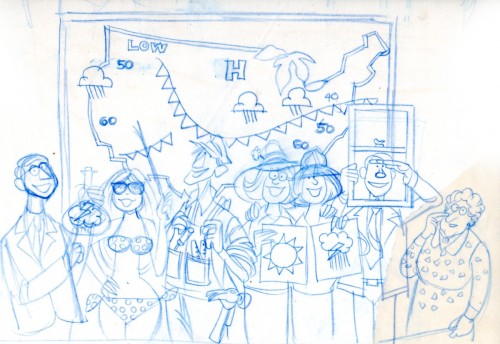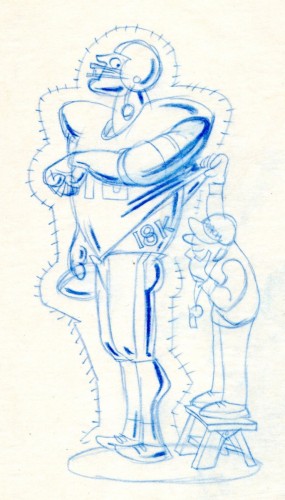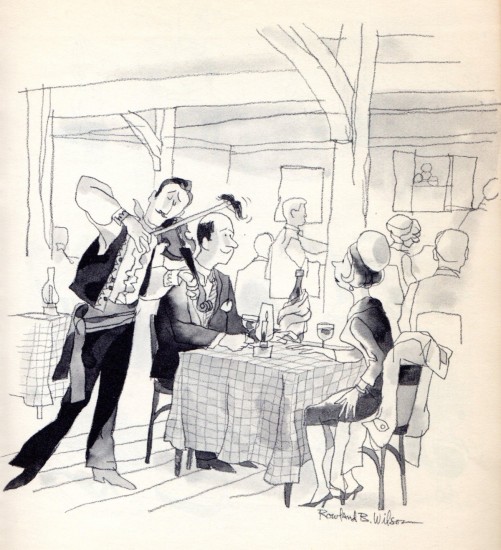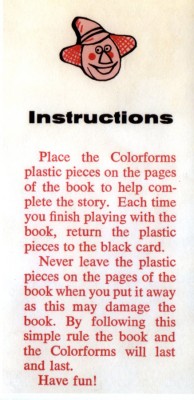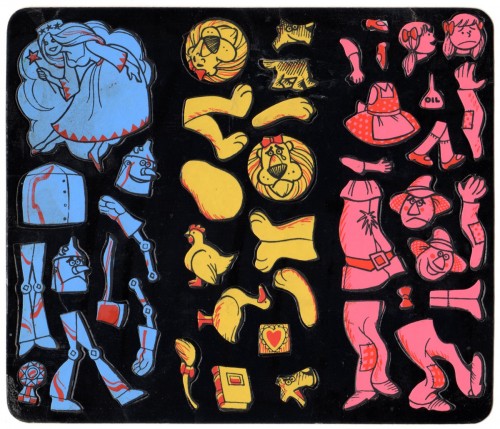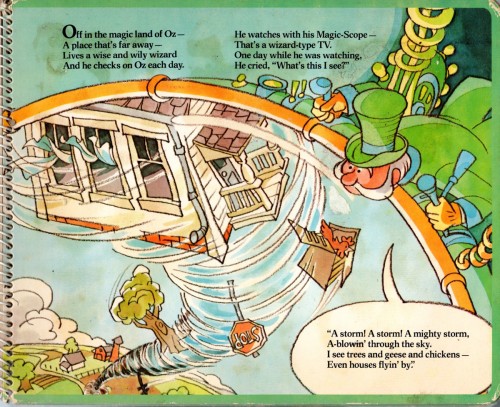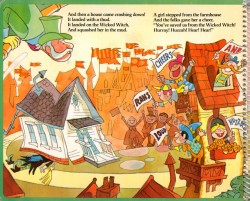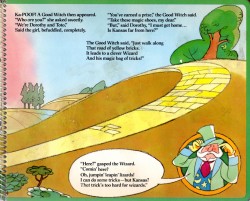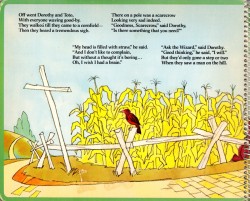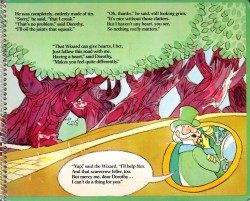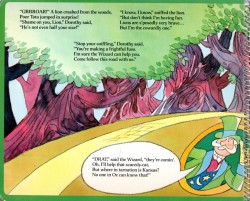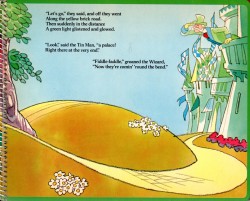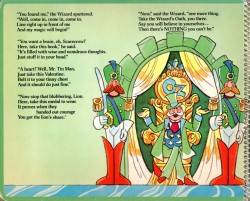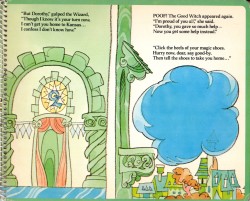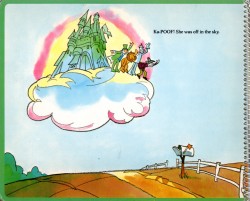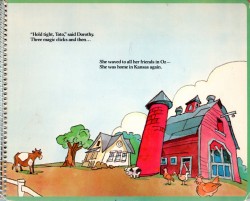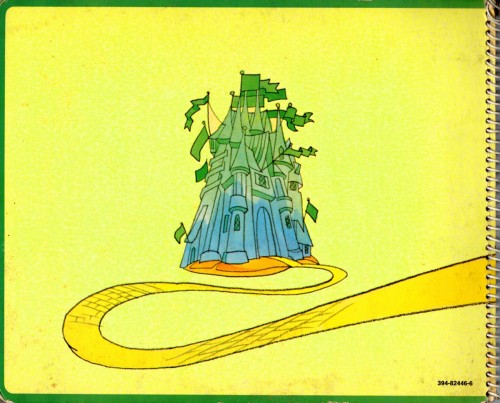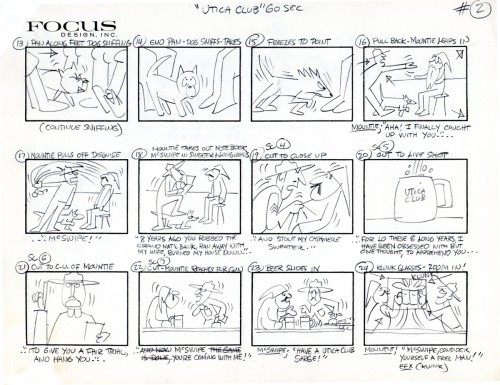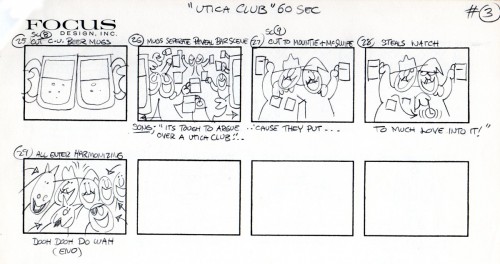Search ResultsFor "Rowland B. Wilson"
Articles on Animation &Books &Rowland B. Wilson 10 Aug 2012 03:34 am
Trade Secrets
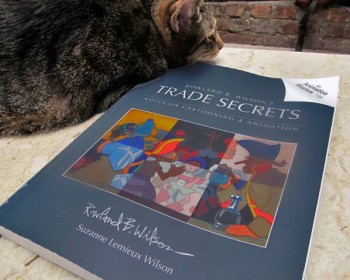 – Finally, I’ve received my copy of the book by Rowland and Suzanne Lemieux Wilson.
– Finally, I’ve received my copy of the book by Rowland and Suzanne Lemieux Wilson.
Rowland B. Wilson’s Trade Secrets / Notes on Cartooning and Animation.
I’d been waiting for this book to come to me since last April when I ordered it. With barely a few hours to scan through it, I can attest to the fact that I think it was well worth the wait. There’s so much there there.
The depth of information on every page is enormous, and just perusing the book, flipping the pages, takes time because the material within is elaborate and complicated. Yet, watching Rowland Wilson break down the information makes you realize what you already know from studying his cartoons: this guy knows a lot, and all of it goes into the choices he’s made in every cartoon.
Consequently, with the book in my hands for only a couple of days, I can’t possibly review it. It’s going to take a long bit of time. I’ll give you a couple of sample pages from the book, so you can see what you’ll be getting if you buy the book (and let me tell you, you should buy this book. It’s a gem, a masterwork of information that’s near-impossible to see collected anywhere. But it takes time.)
The book gives many and varied sheaves of information. At first, I’ve scanned a couple of pages of thoughts on character models. Here are two:
one on women:
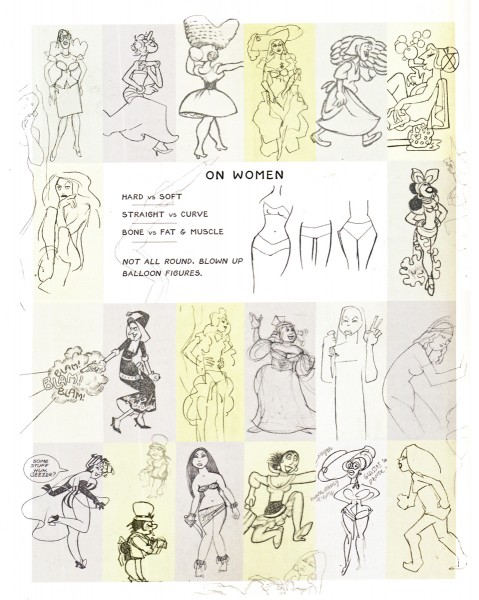 1
1and one on stocky characters:
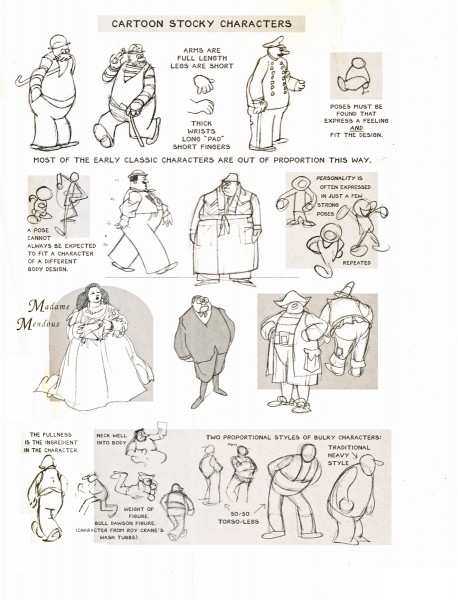 2
2When he gets into the images being created, there’s even a page about iconic imagery within the images being developed. Drawings within drawings.
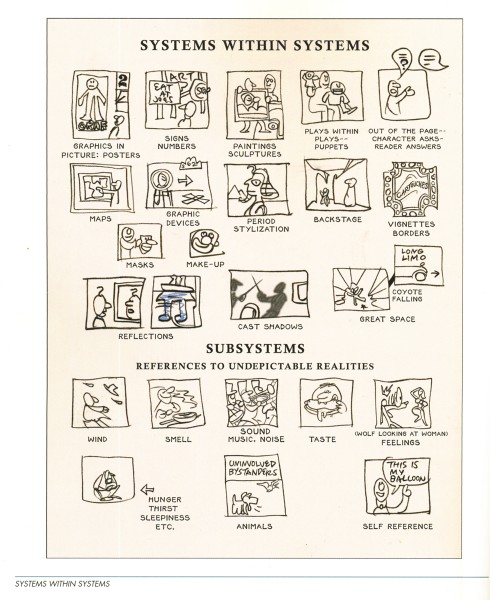 3
3Rowland gets very serious about color and color theories. Here are two adjoining pages which give an overview of color created by varying lighting systems within the drawing.
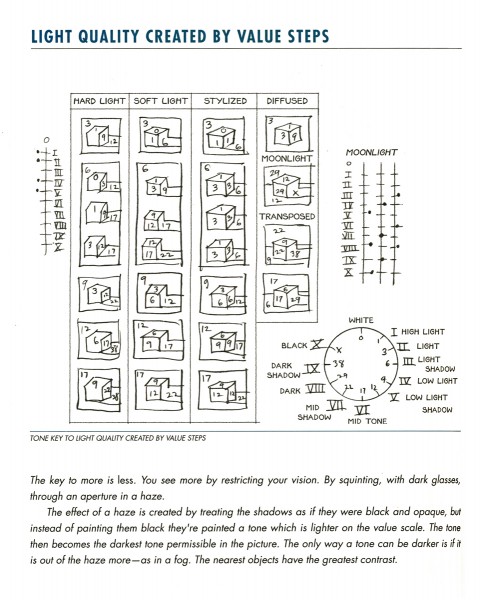 4
4
Then there is the section on notes by the great animators, Grim Natwick and Art Babbitt. This section comes from notes Rowland took at the Richard Williams studio when the two came through the London studio. There were lecture courses given for the studio, and this first page includes some caricatures done at the time.
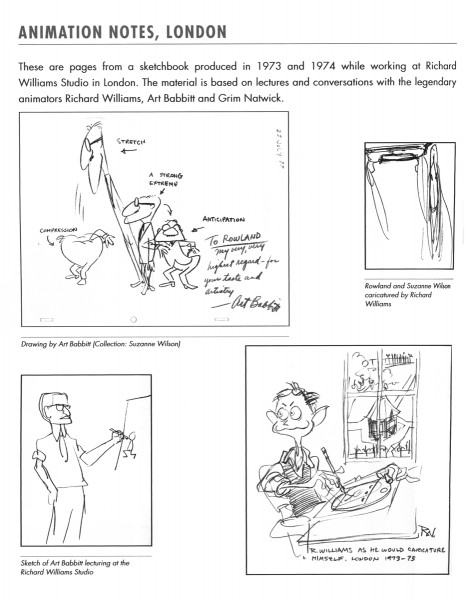 6
6Caricatures done at the Williams’ Studio in Soho Sq.
Here’s a bit of the commentary on Grim Natwick’s lessons:
- GRIM NATWICK AT RICHARD WILLIAMS STUDIO, LONDON
- Grim Natwick was considered one of the world’s greatest animators. He gave a series of talks to animators and was also available for informal conversation during this period (1973-74). We shared the same block of flats and I talked to him often at the studio and after hours. The following is a summation of these talks rearranged according to subject matter.
- GRIM AND THE TRACK— At the time Grim was here I was working on Count Pushkin Vodka (The Trans-Siberian Express animated commercial) and searching for a way to visualize dramatically a musical track. Grim placed great emphasis on the track and the importance of getting to know it thoroughly in order to draw it. At the time he was here I had not started to evolve the the theory of musical form being the basis for animation form. Although Grim never spoke of animation structure as being the same as music structure, on looking back, I see that a number of things he advocated fit into music structure. Art Babbitt’s successive breaking of joints and overlapping action is comparable to the idea of sounding a group of notes in succession, rather than simultaneously. I suspect that the best animators have worked intuitively to principles that are analogous with musical principles. Grim and Art never expressed them that way, exactly.
- DRAWING/ECONOMY— The most controversial theory of Grim’s was to set up a series of related drawings and go into them and out of them and through them in the course of a scene. The animators here felt that the system was not economical due to the amount of mental calculation it took to incorporate a pose in a new way once you had used it. They found the numbering confusing and the doping difficult. Grim presented the idea as an economy and they rejected it on that basis.
- Later in music class it occurred to me the analogy of Grim’s practice with musical practice. The practice of starting with a first and second subject, going through it, repeating it, et cetera,
- I think that Grim’s idea could be called “using a series of HOME KEYS” (animation keys] and is vindicated on aesthetic grounds if not on economic ones.
There’s plenty more where that came from.
Of course, finally, I had to copy this chapter page which includes this great self-caricature by Rowland.
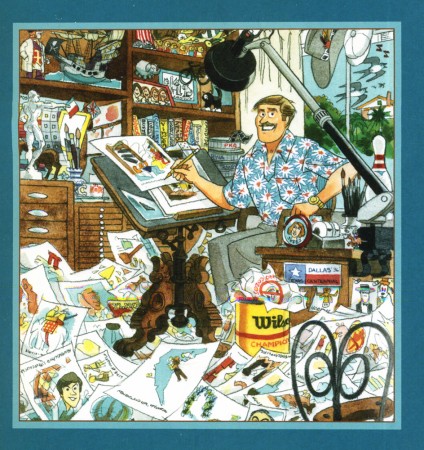
This is a book filled to overflowing with knowledge and information. It makes me realize how little I know and how much there is to learn from masters like Rowland Wilson. He talks briefly about the ad he designed/directed for Riichard Williams, Count Pushkin Vodka. Seeing this ad, alone, is enough to tell you how brilliant Mr. Wilson is and how key it is to learn from such a master. It also says a lot about the man that he spent time preparing these lessons. It also tells me how grateful I am to Suzanne Lemieux Wilson for organizing this material and getting it into shape for publication; I’m sure that was no easy task. I’ll have this book in hand for quite some time to come. In a way, it compares favorably to Richard Williams’ own book on animation, The Animator’s Survival Kit. The difference is that Williams’ book is about acting, performance, and animation; this book is about design, direction and the bigger picture.
Animation &Commentary 07 Aug 2012 06:20 am
Jack Schnerk, again
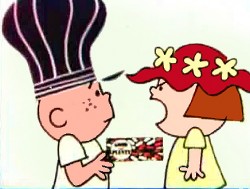 - Jack Schnerk‘s daughter, Mary Schnerk Lincoln, has put three of her father’s commercial sample reels onto YouTube .
- Jack Schnerk‘s daughter, Mary Schnerk Lincoln, has put three of her father’s commercial sample reels onto YouTube .
Just last week I found myself using one of those reels to showcase a Rowland Wilson designed commercial done for Phil Kimmelman & Ass. Seeing that reel again, brought me back to the other two reels on YouTube, and the great work animated by Jack. There are a number of well-known and collector’s item commercials in these reels. Included are spots designed by the likes of Gahan Wilson, Tomi Ungerer, Charles Saxon and, of course, Rowland Wilson.
Jack Schnerk was a great animator who deserves considerably more attention. He was a strong influence on me in the first eight years of my career and taught me quite a few large principles about the business. He also told me a few stories of his work as an assistant at Disney’s on Bambi and Dumbo as well as the great times animating at UPA and the difficulties of animating at Shamus Culhane’s studio. Actually, he didn’t tell me about his problems with Shamus; another animator did. Jack complained about the business, but never about how he was treated.
He did have an exercise which he thought was important for an animator to pass. He suggested you animate a character walking in a 360° circle away from and back toward the camera. This is a tough test of mechanical ability, and Jack is right; it’s tough and can prove your mettel. (Milt Gray does just that with his somewhat vulgar character, Viagri, but the animation is impeccable. Milt’s a first rate animator.)
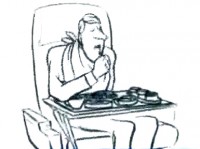 I wish I had more samples of the many scenes Jack animated that I assisted. He worked in a very distinct style – I don’t think I’ve seen anyone else ever draw that way. Somehow, the very rough drawings weren’t hard to clean up, and, though he worked very rough, he didn’t leave the bulk of the work for the people following him. He was concerned about the timing and did every drawing he needed to make sure that timing worked. Most of the time we worked together, he had no chance to see pencil tests. Only on Raggedy Ann did he have that luxury, yet he was always taking a chance on the scene, pushing to some new way of doing it. I think of all those Hubley scenes that went to color art, yet Jack had done some daring moves that could have made some of the scenes go bust. None ever did.
I wish I had more samples of the many scenes Jack animated that I assisted. He worked in a very distinct style – I don’t think I’ve seen anyone else ever draw that way. Somehow, the very rough drawings weren’t hard to clean up, and, though he worked very rough, he didn’t leave the bulk of the work for the people following him. He was concerned about the timing and did every drawing he needed to make sure that timing worked. Most of the time we worked together, he had no chance to see pencil tests. Only on Raggedy Ann did he have that luxury, yet he was always taking a chance on the scene, pushing to some new way of doing it. I think of all those Hubley scenes that went to color art, yet Jack had done some daring moves that could have made some of the scenes go bust. None ever did.
I met Jack at the Hubley studio, then again when I worked for Phil Kimmelman. At Raggedy Ann, I dropped Jack’s name as often as I could until Dick Williams finally saw him, and brought him on board. There was no doubt he would, Jack was that gifted. At least once a week at Raggedy Ann, Jack would give me some original piece of advice, and the more I followed it, the better my work grew. Something as simple as draw rough. I’d been an assistant too long, and my clean line would assure that my animation would never move out of those lines.
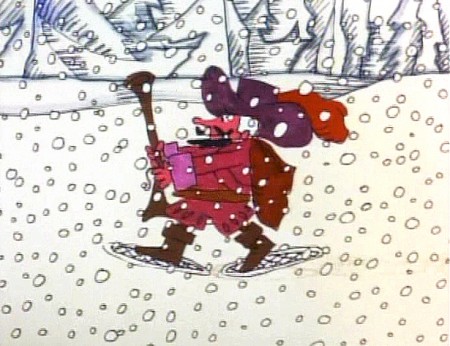
Jack Schnerk animated the French trapper sequence. There was such a rush
on the scene that I remember Jack bringing it in saying he hoped it would work.
Jack had a dark side, that I appreciated, but he also brought a lightness and individual sensibility to the work he did. He took chances in his animation and timing and sometimes failed but usually succeeded with them. That’s more than I’ll say for most of the animators I’ve met in the business.
See
Though not always the best quality, you can also watch a few of the longer, famous short films Jack animated on:
- Gerald McBoing Boing by Bobe Cannon. Jack told me that this includes the first scene he ever animated, even though he didn’t get credit. He did Gerald running alongside the train (starts at 4:41)
Tender Game by John & Faith Hubley
Really Rosie directed by Maurice Sendak
A Nose by Mordi Gerstein
The Violinist by Ernie Pintoff
Give Me Liberty by Ralph Bakshi is one of many bad shorts done for Terrrytoons at the end when Bakshi was in charge.
After reading this post today, Bill Peckmann sent the following note:
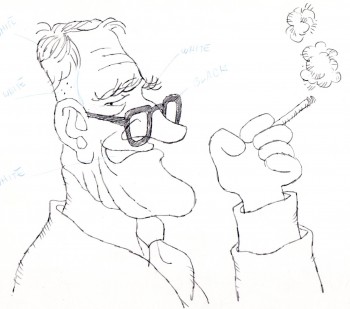 Hi Michael,
Hi Michael,
Your post today on Jack was just wonderful!
When I broke into the business in 1962 at Elektra Films, Jack’s room was the one they put me into. It was pure heaven! As a super, wet behind the ears novice, to be in the same room with someone that had ACTUALLY worked at Disney and UPA, you gotta be kiddin’!
My luck held out further because I assisted/followed up Jack (at Focus and PK&A) on all of the print cartoonist/designer spots you mentioned today. I would have done that work without pay! The combination of Rowland and Jack on a job, I still need smelling salts.
As when we all worked on Rowland’s spots, where I did those caricatures of Jack, ‘Sounds of Focusville’ and ‘Kimmelman of the Klondike’, I also did this caricature (attached) in Gahan’s style of Jack when we worked on ‘Carter Hall, Pipe Tobacco’ together.
I will pull together Xerox copies, pencils and stats of the art of Gahan, Bob Weber, who ever I can lay my hands on, etc. of the spots that Jack animated plus a JS rough or two.
We can look forward to more of Jack Schnerk next week, thanks to Bill’s collection.
Books &Comic Art &Illustration &Rowland B. Wilson 03 Aug 2012 05:38 am
Rowland Wilson – Esquire

Today’s the anniversary of Rowland B. Wilson‘s Birthday,
and I have a great post to celebrate it.
- Completing the scanning and posting of Rowland Wilson‘s book, Whites of Their Eyes, I received a note from Suzanne Wilson and a series of scans of some beautiful color art by Rowland. Here’s that note:
- Hello Michael,
- It’s exciting to see Rowland B. Wilson’s “The Whites of Their Eyes” revisited. Perhaps your posting will initiate another half-century of shelf life to these cartoons!
- Originally, most of them were presented in color but due to printing restraints of the time they did not appear that way in the book. I think Rowland said he had to rework some of them as line drawings.
- I thought it might be of interest to make a comparison with the color versions. In the process I came across additional material from Esquire that wasn’t included in “Whites”, as well as from some unknown publications. They are interspersed here in no particular order.
- Image 07, the lighthouse keeper, was selected by the great psychologist, Carl Jung as an illustration in “Man and His Symbols”. It was reprinted recently in “Understanding Psychology”, published by McGraw-Hill.
- Thank you for keeping the RBW humor and oeuvre alive.
- Sincerely,
Suzanne
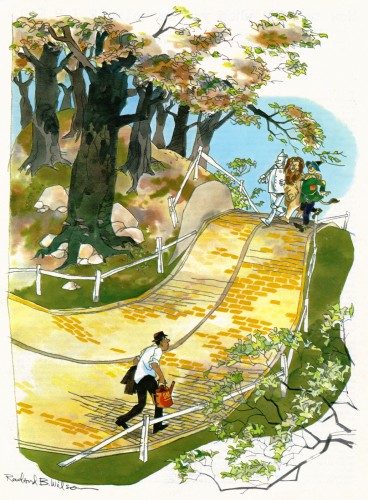 1
1
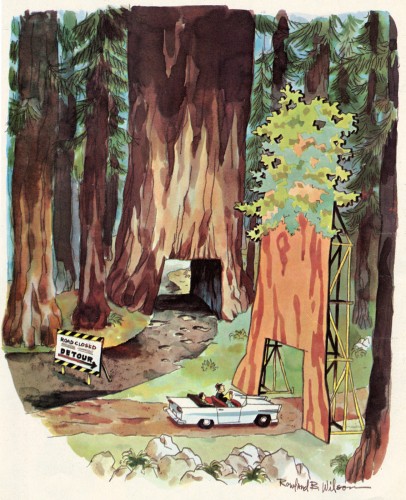 13
13
Finally, here are two drawings in honor of the Olympics:
According to Amazon, Suzanne Wilson’s book, Rowland B. Wilson’s Trade Secrets: Notes on Cartooning and Animation, was released yesterday, and is Out of Print with LIMITED AVAILABILITY. I guess that when I said to get one soon, a lot of people were listening.
This is a book I’ve been looking forward to reading for quite some time. I’m curious about the “Cartooning” part, but I’m wildly interested in seeing the “Animation” part. Rowland was a master of design when he worked in animation; I want to read anything he has to say about it.
Bill Peckmann &Books &Comic Art &Illustration &Photos &Rowland B. Wilson 02 Aug 2012 05:23 am
Whites of Their Eyes – 4
- This is part 4 of 4 of the Rowland B. Wilson book, Whites of Their Eyes. You can find the other three parts here: Part 1, Part 2, Part 3.
The book was scanned and sent to me by Bill Peckmann, and, of course, he’s the one to thank for this great material from this 1962 book. Here are the final images from the book, and boy are they good.
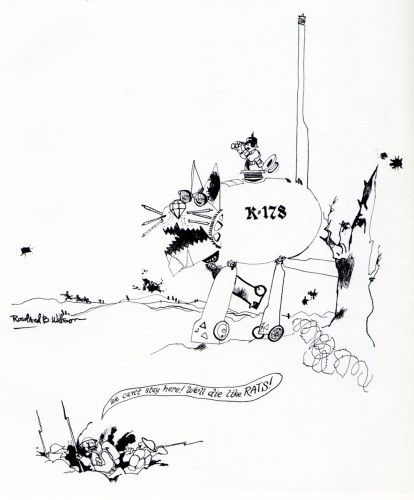 1
____________________________
1
____________________________Bill Peckmann sent me the following note with the scans:
-
For all fans and friends of Rowland B. Wilson, I just want to give Suzanne Lemieux Wilson a big standing ‘O’ and a shout out of our appreciation for authoring the very soon to be released book ‘Rowland B. Wilson’s Trade Secrets, Notes On Cartooning & Animation‘. Without her diligence and heavy lifting of putting this book together, we would never have seen this wonderful collection of RBW art in print form, plus the added topper of actually finding out Rowland’s thoughts and reasoning that went into producing the art that we’ve come to know and love. Suzanne, again, many, many thanks!
Here’s a little photo trip down memory lane with Suzanne and Rowland.
(England 1973.)
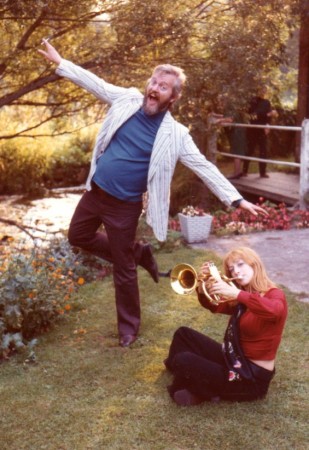
England 1973
Bill Peckmann &Books &Comic Art &Illustration &Models &Rowland B. Wilson 20 Jul 2012 05:43 am
Whites of Their Eyes – 2
- Several years ago, I’d posted Bill Peckmann‘s xeroxed copy of Rowland B. Wilson‘s 1962 book, Whites of Their Eyes.
Bill has now sent me new scans from the book, itself, and they’re worth posting in this better state. I hope you enjoy the diversity of Rowland’s style in the wide range of cartoons he’d done by 1962.
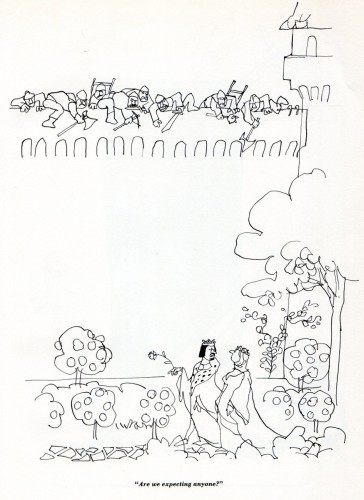 1
1
 26
26
In 1981, nestled in their idyllic abode in the cartoonist’s and
illustrator’s haven of Westport, CT., Rowland and Suzanne Wilson
had their own British invasion…
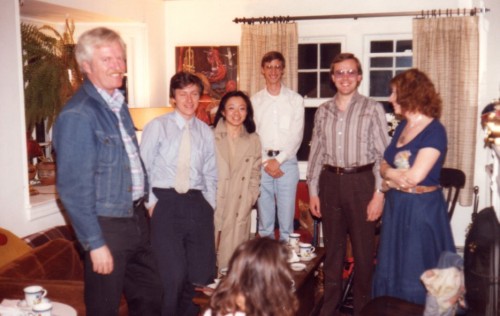 27
27
…It was colleagues and friends of Rowland’s that he had
worked with previously at Richard Williams Studios in London.
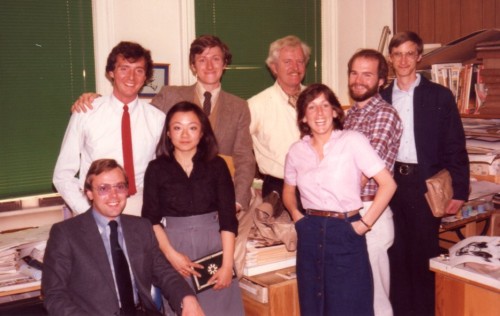 28
28
Following the visit to Rowland’s house, everybody dropped by
to see Row in his room at the PK&A Studios that he shared
with Bill Frake (Standing far left) and myself. Mark Mayerson (standing far right)
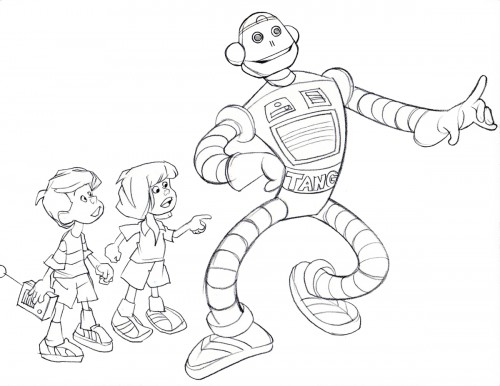 29
29
The following pencil sketches are by RBW, from about the same
time period as the visit. They were done for ‘Tang’ commercials,
Rowland designed the characters and did the BG’s.
Bill Peckmann &Comic Art &Illustration &Rowland B. Wilson 13 Jul 2012 08:46 am
Whites of Their Eyes
A couple of years ago I’d posted some cartoons from Rowland B. Wilson‘s 1962 book, Whites of Their Eyes. (You can see two of them at: part 1 and part 2.) However these posts were from a xeroxed copy of the book and the quality was a bit shabby.
Bill Peckmann now has a copy of the book and has sent me new scans of these great cartoons. Bill writes:
- It’s kind of hard to believe that this 1962 collection of Sat. Eve. Post, the New Yorker and Esquire gags are from the beginning, formative years of Row’s early career. He was only 32 years old when this book came out. Most of us would be happy to top off a career with this kind of exceptional work.
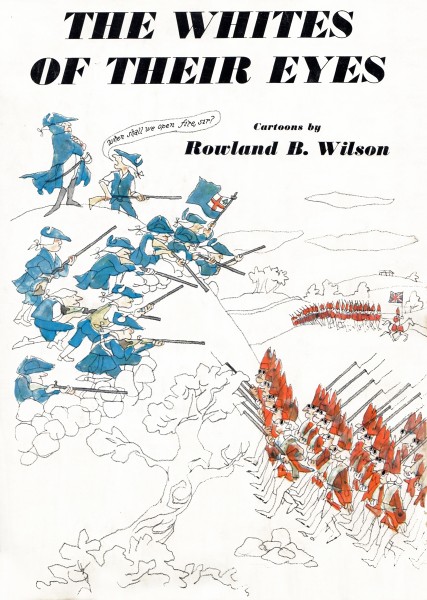
The book’s dustcover
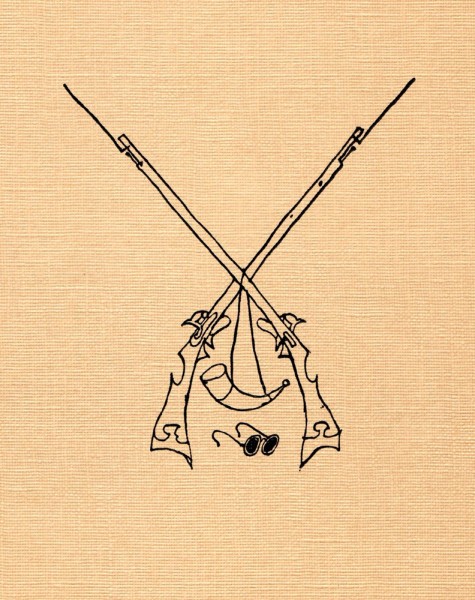
The actual book’s embossed hard cover.
.
Here is an upbeat ’1984′ happening. Two legends in their own time, Carl Barks and Rowland Wilson, got to meet each other for the first time in Carl’s home town of Grants Pass Oregon. It was definitely a mutual admiration society!
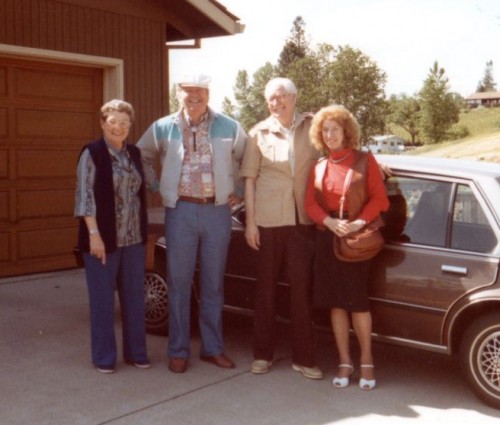 1
1left to right, Gare Barks, Rowland, Carl and Suzanne Lemieux Wilson.
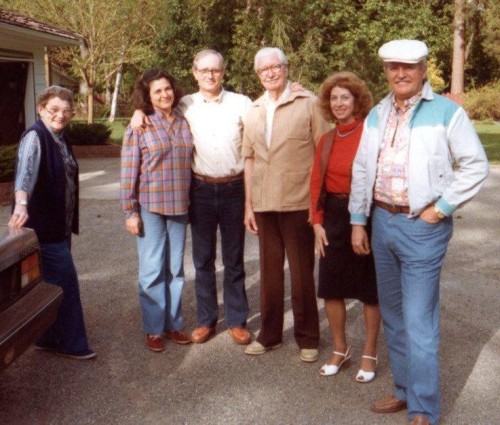 2
2
The Barkses were then kind enough to introduce us to their good friend,
cartoonist Russell (Broom-Hilda) Myers and his wife.
L. to r. Gare, Mrs. and Mr. Russ Myers, Carl, Suzanne and Rowland.
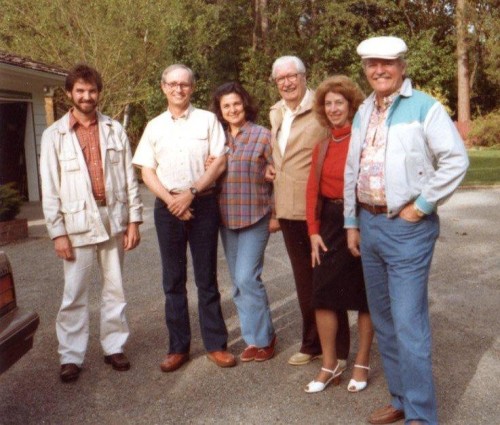 3
3
L. to r. Bill Peckmann, Russ and wife, Carl, Suzanne and Rowland.
Bill Peckmann &Books &Comic Art &Illustration 26 Jun 2012 06:31 am
Animal Gags à la the New Yorker
- I love getting these out of the blue emails from Bill Peckmann, followed by a flurry of great cartoon scans.
Here’s the latest and his comments prior to sending:
- I just came across this 1979 book of mine, a collection of animal gags, all collected from past New Yorker cartoons, it has a bunch of our favorite cartoonists in it, Rowland B. (only 1 gag of his, but it’s a good one not seen before), 4 Peter Arno’s, 3 Whitney Darrow Jr.’s, 6 Charles Addams’, and of course the author/editors Gahan Wilson and George Booth, plus many more, all rib ticklers
With not one, but two legendary magazine gag cartoonists editing this 1979 collection of animal gags, what else can I say but enjoy!
Here’s a small portion of their pick of the litter.
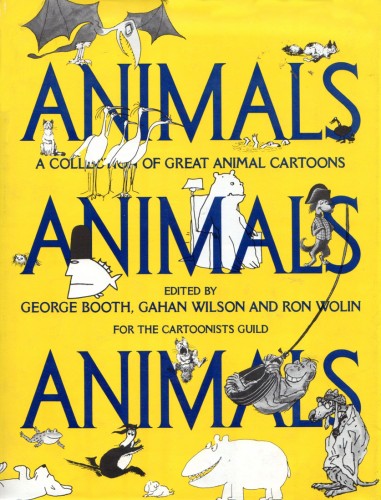
The book’s Cover
.
Many thanks to Bill Peckmann for the scans.
Bill Peckmann &Illustration &Rowland B. Wilson 22 Jun 2012 05:40 am
Another RBW assorted
- Suzanne Wilson has sent me some scans of beautiful artwork by her late husband, Rowland B. Wilson. What magnificent draftsmanship. His compositions are extraordinary and his color design is just beautiful. I takes my breath away to see how simply these are composed, yet the drawing is just so expert.
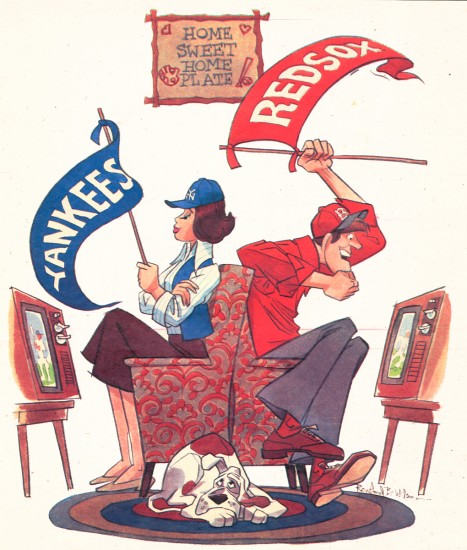 1
1“Jean and Stephen are a loving couple–she loves the Yankees
and he loves the Red Sox”
Sunday News Magazine, New York, August 6, 1978
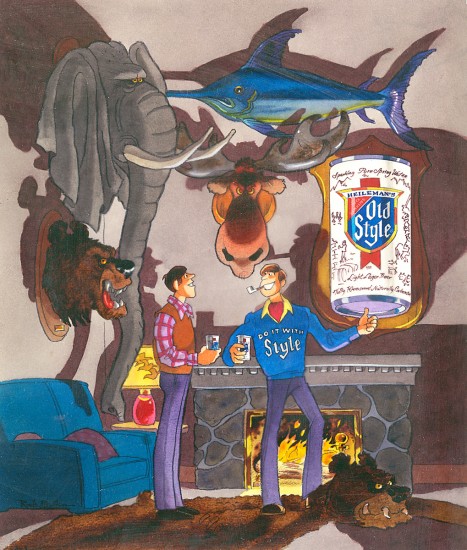 2
2
Old Style Beer
“…and I downed this one at the corner bar!”
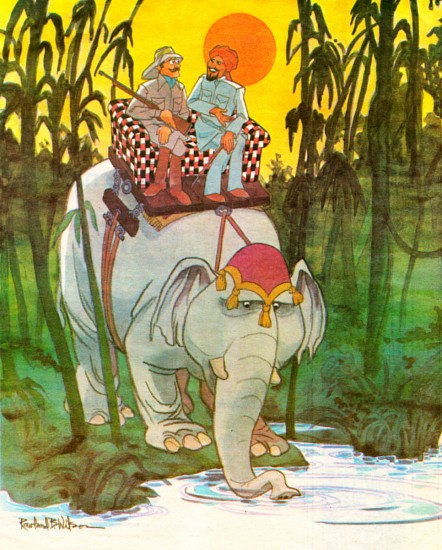 3
3
“All my elephant chairs are upholstered with fabric made of “Belviva” yarn.
Under a sun like this, we need all the fade resistance we can get.
Collins and Aikman
HFD, Retailing Home Furnishings April 3, 1978
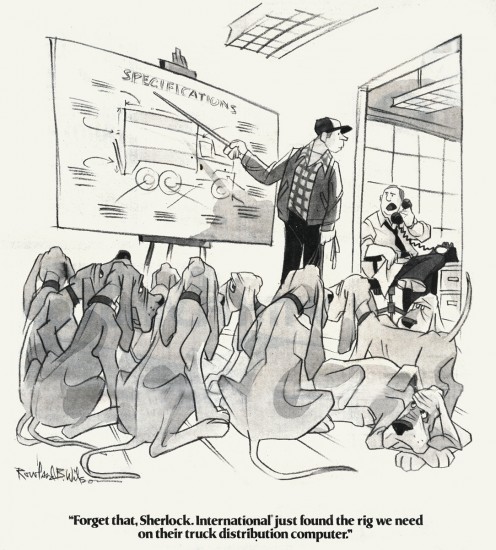 4
4
“Forget that, Sherlock. International just found the rig
we need on their truck distribution computer.”
International Trucks, The Wall Street Journal, September 21, 1976
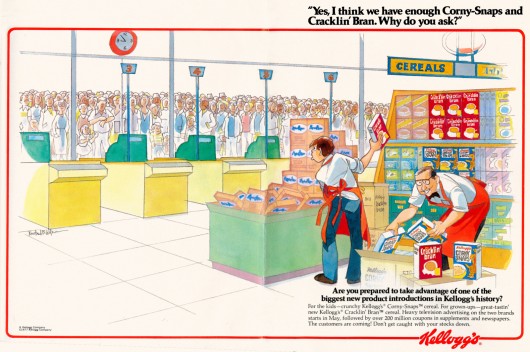 “Yes, I think we have enough Corny-Snaps and Cracklin’ Bran. Why do you ask?”
“Yes, I think we have enough Corny-Snaps and Cracklin’ Bran. Why do you ask?”
Ad text: “The customers are coming! Don’t get caught with your stocks down.”
Kellogg’s for magazine ads, 1977
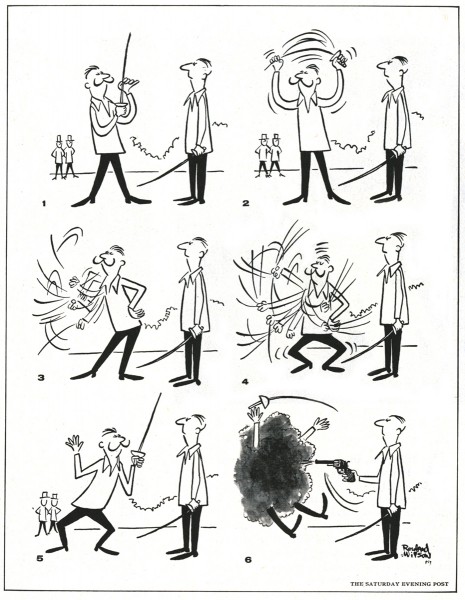 6
6
Way before Indiana Jones!
The Saturday Evening Post, May 19, 1956

Esquire Bourbon Dog
This was obviously a header for an Esquire article.
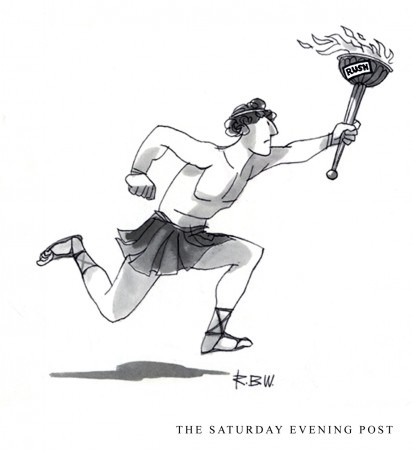 10
10
The Olympic Torch for
The Saturday Evening Post
Bill Peckmann &Illustration &Rowland B. Wilson 15 Jun 2012 06:52 am
Rowland Wilson Calendar
- Continuing with the odd jobs posted yesterday.
In 1987, Rowland B. Wilson released a calendar called Murphy’s Law.
Bill Peckmann has forwarded the illustrations from it, and I’m posting them here.
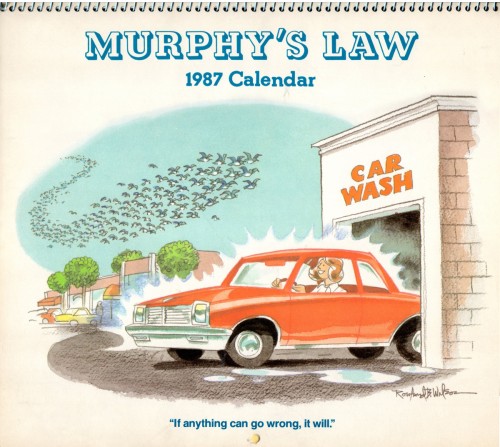
The cover and June
June is already visible as the cover.
__________________________________The following are some additional rough pieces by Rowland.
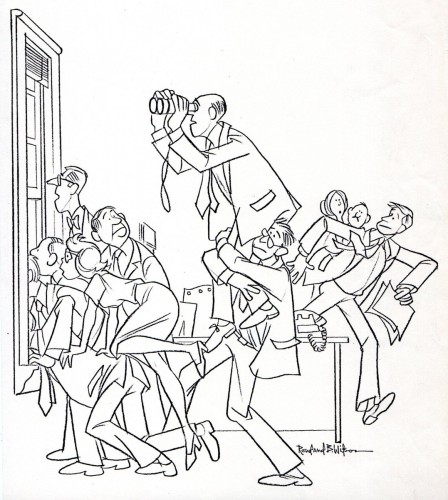 1
1
A Xerox of Row’s line drawing before the color elixir was added!
Great posing!
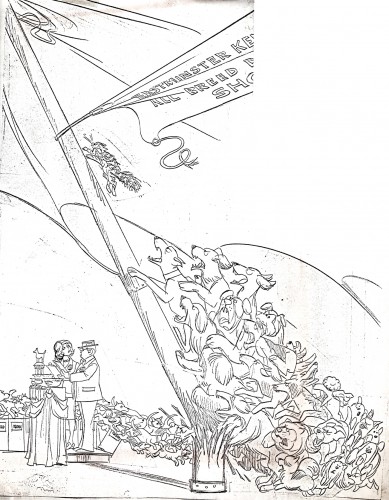 2
2
Unfortunately this is an old faded Xerox, but here is a New
England Life ‘Dog Show’ gag. I’m sending it because of all
of the dogs in it, man, you can’t shake a stick at them,
they are just phenomenal! Catch all of the different breeds.
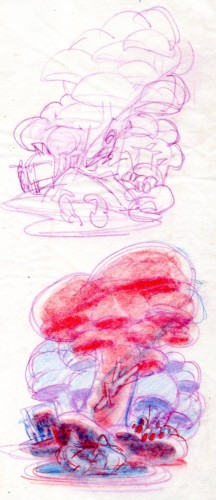 5
5
Two small thumbnail sketches before
starting to paint Playboy ‘Robin Hood’ gag.
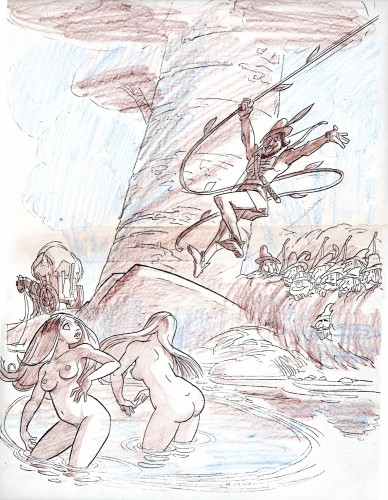 6
6
For gags that were extra special to him, Rowland would
pre plan and work out the color shading on a Xerox of
his line drawing. Here again is ‘Robin Hood’.
Rowland would usually discard his roughs after finishing a job,
but for some reason he kept a small stash of them at PK & A,
so when the studio finally closed it’s doors and we asked Row
what to do with them, he said dump ‘em. Which I promptly did
into my attache case! Since then I’ve found out from Suzanne Wilson
that for what ever reason, RBW did not hang on to his roughs,
much to her dismay. So what we see here is something on the rare side.
It’s ironic because Rowland always understood the passion and
vitality of everyone else’s roughs.
.
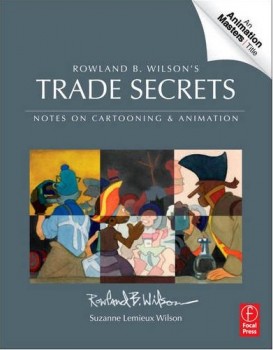 – Finally, Trade Secrets : Rowland B. Wilson’s Trade Secrets: Notes on Cartooning and Animation has had a release date changed. Amazon is promising it’s pre order customers that we should get our copy the beginning of Aug.
– Finally, Trade Secrets : Rowland B. Wilson’s Trade Secrets: Notes on Cartooning and Animation has had a release date changed. Amazon is promising it’s pre order customers that we should get our copy the beginning of Aug.
Rowland Wilson‘s journals, in which he wrote about illustration and animation, have been gathered by Suzanne Wilson and are collected in this book. The information must certainly be very informative to students; the book seems to offer quite a bit of attention to Mr. Wilson’s animation art, just as it does his brilliant illustration and cartooning. I’m looking forward to seeing the book and will certainly make sure you know what I think of it when it does come out.
Bill Peckmann &Illustration &Rowland B. Wilson 12 Jun 2012 06:39 am
Rowland Wilson Assortment
- Rowland B. Wilson did many different types of illustration over the years. Thanks to Bill Peckmann and the loan from Denis Wheary we can post some of these oddities.
Here is a 1962 book from the Columbia Record Club titled ‘Musical Cartoon Album’. It included cartoons by an assortment of the well known cartoonists of the day. Rowland had his gag in there, fortunately for us.
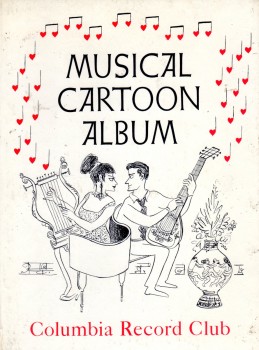
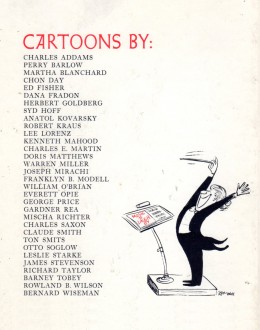
Front Cover / Back Cover ____________________________
There is the prestigious job of doing a book for Colorforms. I’m not sure if they even have Colorforms today. It was a shiny plastic/rubberized sort of cut out doll that you’d pick up and place on the other pages of the book to form your own pictures. There was even a set in the Museum of Modern Art that just dealt with abstract shapes that you’d recreate into your own 20th Century Art Form. Bill Peckmann writes:
- ‘Wizard of OZ’ is a super find that Denis Wheary made. Both Suzanne Wilson and I were not aware that Rowland had done the book. We’re both trying to come with a publishing date, but the nearest we can come to is probably the very early 1970′s. It was definitely before Row went to Richard Williams in 1973. Those were the years RBW was very hot in the print world and a had an ace sales rep, he did not get much sleep in those days.
This is The Wizard of Oz, drawn and designed by Rowland. To get the sense of the book, I’ve posted small thumbnails of the images so they can sit side by side. If you click on any of the images it’ll enlarge to a good readable size.
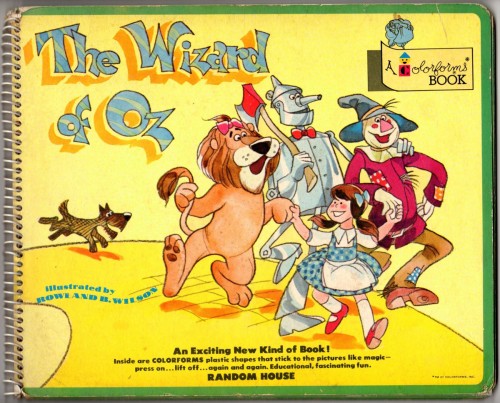
Front Cover
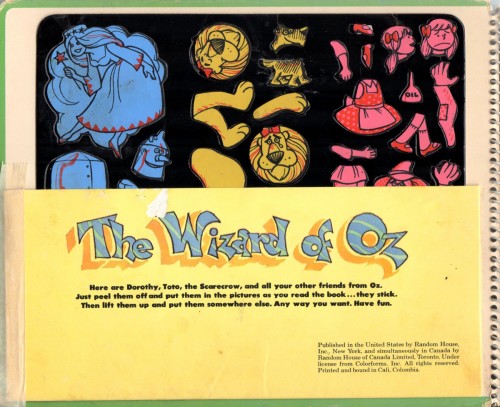
The card with the Colorforms on it came in a sleeve on the title page.
Here from 1977, is an editorial illustration Rowland did for the Sunday supplement of the New York Daily News. The yellowing of the newsprint paper is starting to show, but that seems to work with the subject matter of the illustration.
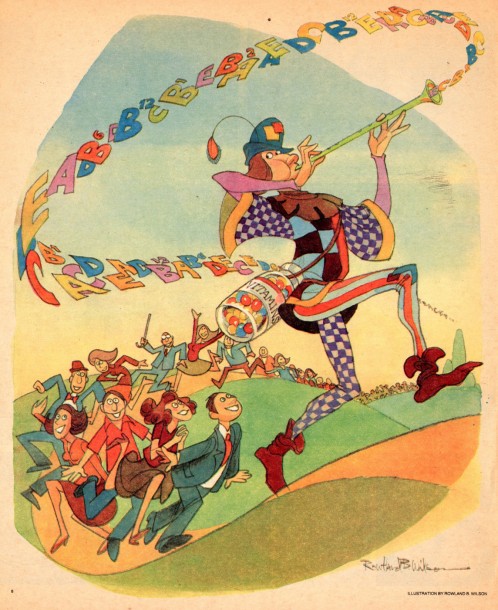
____________________________
Since you’ve already posted art from Rowland’s 1970′s Utica Club’s ‘Mountie’ TV commercial a number of years ago, I thought you might like to see the original thumbnail, production storyboard of that spot.
It’s a collaboration between Rowland and Phil Kimmelman done at Focus Design Studios.
Rowland always knew how to make a person feel good, even years later after working at all of the different animation studios that he did, he would tell us, that he always remembered those early animated commercial days as some of his most favorite, he just loved those ‘jam sessions’, and man, so did we!. It also helped that ad agencies picked Rowland to do the spot, which meant he was given carte blanche!
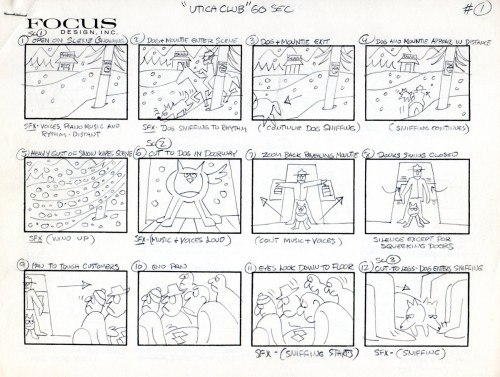 1
____________________________
1
____________________________Finally, here’s a piece of RBW spec art done to land a TV spot at PK&A. Sadly the ad agency’s brains were out to lunch and the job never happened. (Circa 1980)
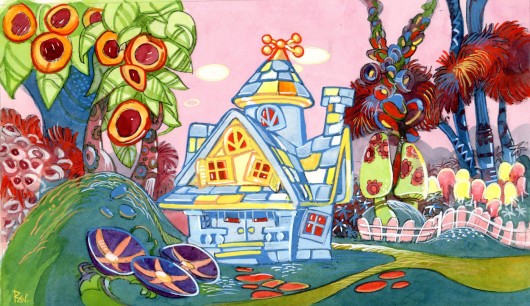
We’ll continue this post on Friday.
